The Phyrexian invasion is over, and the Multiverse is safe from compleation. But the ravages of their incursions have scarred a multitude of planes, and Eldraine in particular has suffered devastating consequences. The High King and Queen are dead, the Courts are scattered, and the Wicked Slumber is encroaching upon the benighted population.
Wilds of Eldraine returns to the plane of Arthurian knights and fairy tales - only the knights are far diminished, allowing for a surge of fae mystery and mischief. As a result the orderly mono-colored themes of Throne of Eldraine are gone, replaced by mechanics that feel both magical and whimsical… and maybe a little deadly. How so? Let’s take a look!
Mechanics and Themes
Roles
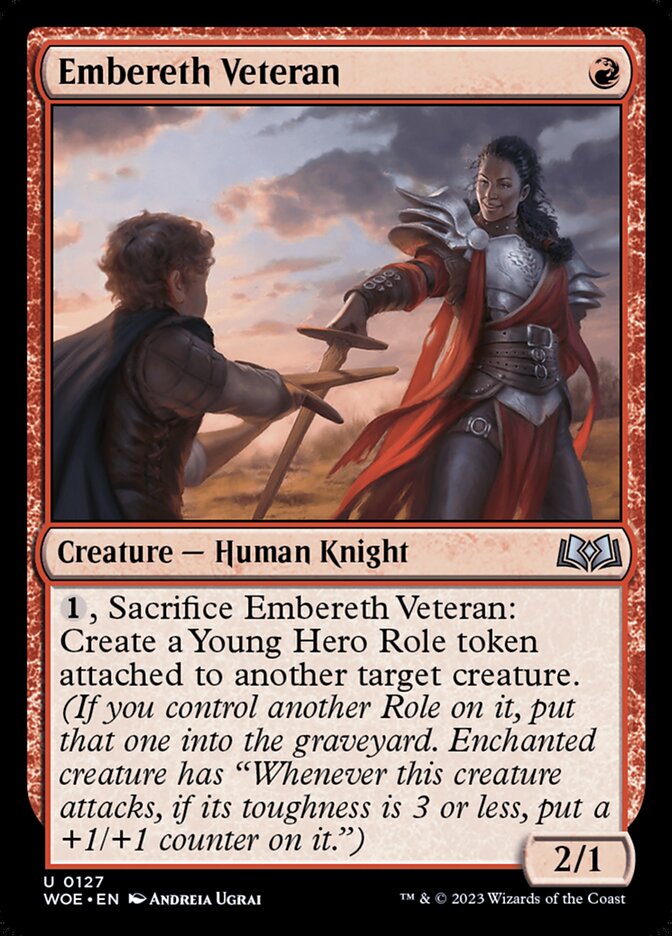
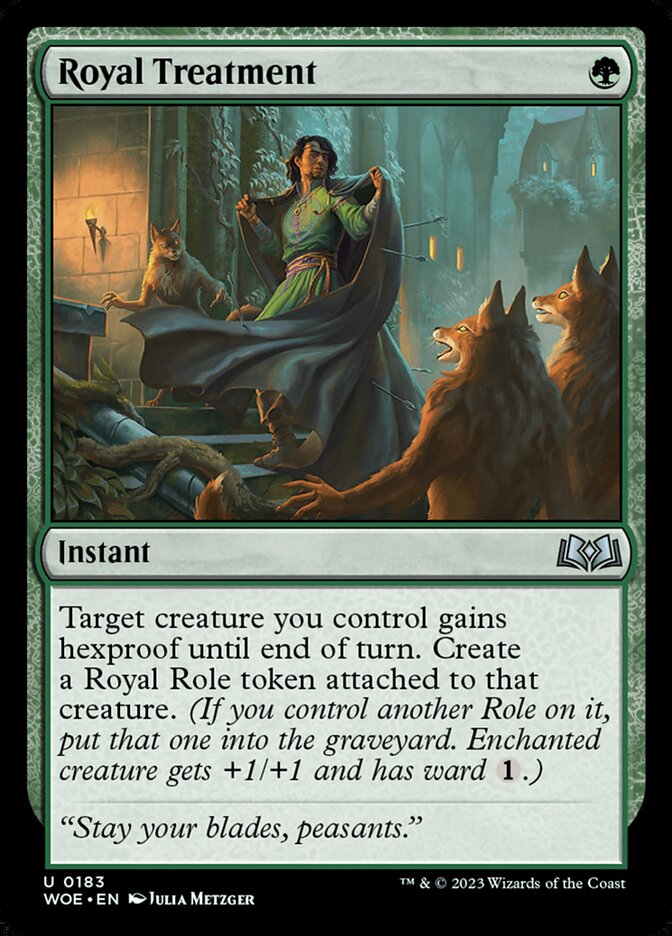
This is the signature mechanic of WOE: Roles. Roles are token enchantment auras, created by a substantial number of spells and effects. A creature can be enchanted with one Role per player; if a player dumps an additional Role on a creature, then the previous Role is discarded.
There are six Roles. Five of them are beneficial:
Monster - Enchanted creature gets +1/+1 and has trample.
Royal - Enchanted creature gets +1/+1 and has ward 1.
Young Hero - Enchanted creature has “Whenever this creature attacks, if its toughness is 3 or less, put a +1/+1 counter on it.”
Sorcerer - Enchanted creature gets +1/+1 and has “Whenever this creature attacks, scry 1.”
Wicked - Enchanted creature gets +1/+1 and “When this Aura is put into a graveyard from the battlefield, each opponent loses 1.”
And one is negative:
Cursed - Enchanted creature has base power and toughness 1/1.
Roles are mechanically new and unique, and therefore an attractive toy in Limited. But beyond that they’re also a glue mechanic for WOE. Not only do they (obviously) serve an enchantment theme; they also enable nearly every other set mechanic and theme as described below.
Role producing cards are found in every color. Expect most decks to have a fair amount of them.
Bargain
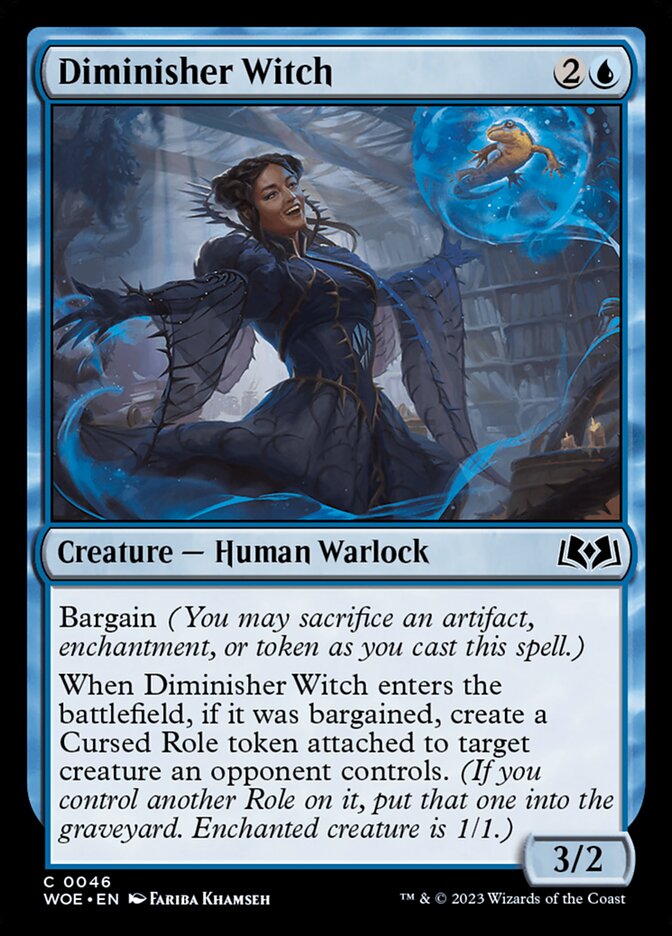

A spell with Bargain has an added beneficial effect if you sacrifice an enchantment, artifact, or token as you cast it. In some sets this would be a substantial cost; however WOE has plenty of fodder lying around thanks to Roles, with some that you may be actively looking to sacrifice. The set also has a variety of creature tokens that may end up outclassed on the battlefield, and therefore far more useful as a spell enhancer.
Bargain cards are present in every color.
Celebration
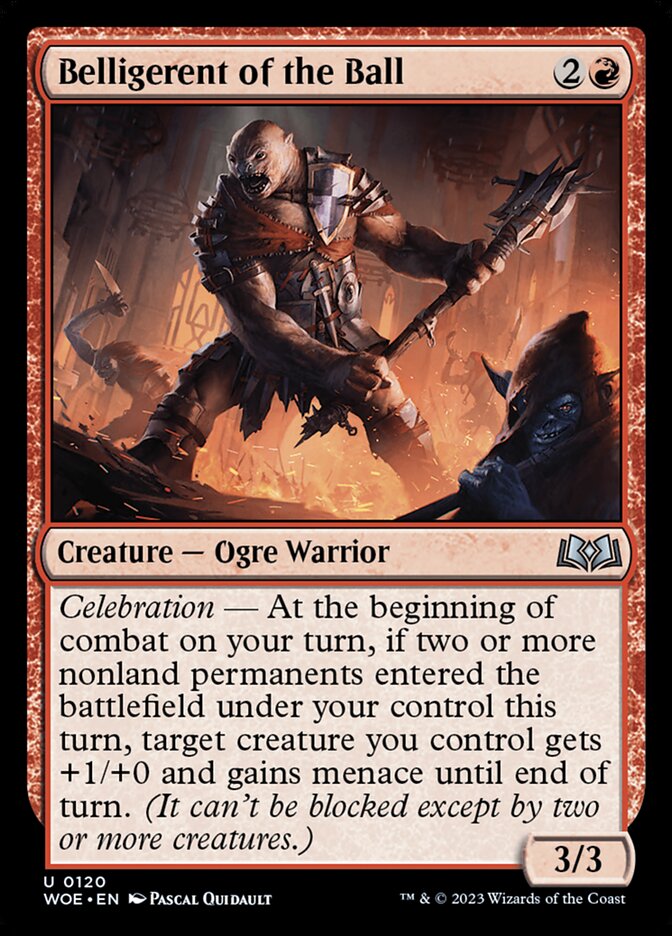

Celebration is a simple ability that triggers if two or more non-land permanents enter the battlefield under your control. A deck that wants to trigger Celebration can either dump out a lot of cheap permanents, or take advantage of the large number of creatures and enchantments that create tokens such as Roles.
Celebration buffs are designed to be combat oriented; as such, they are found in Red and in White.
Adventures


Not all is unfamiliar in WOE, as Throne of Eldraine’s much beloved mechanic returns: Adventures. Some permanents in WOE have a sub-card within them: an instant or sorcery with the Adventure subtype. Either half of these spells can be cast - but if you cast the Adventure half first, then the card is placed into exile, and you can cast the non-Adventure half later. This means that every Adventure card is potentially two cards in one, and an extremely valuable source of card advantage.
In Throne of Eldraine it was often a non-brainer to gain value by always casting the Adventure half first. WOE occasionally makes the choice a little more difficult in a variety of ways. First: there are a higher number of Adventures where the Adventure half is more expensive than the other half, giving you a choice between value and immediate board presence. Second: WOE introduces Adventures where the two halves are different colors, allowing you to take an Adventure with the intent of only casting one half (or perhaps splashing for one half of the Adventure).
There are also some cards that interact with Adventures in interesting ways. For example, Chancellor of Tales allows you to copy your Adventure spells - quite a powerful effect, and one that turns the value of Adventure cards into something excessive.
Food
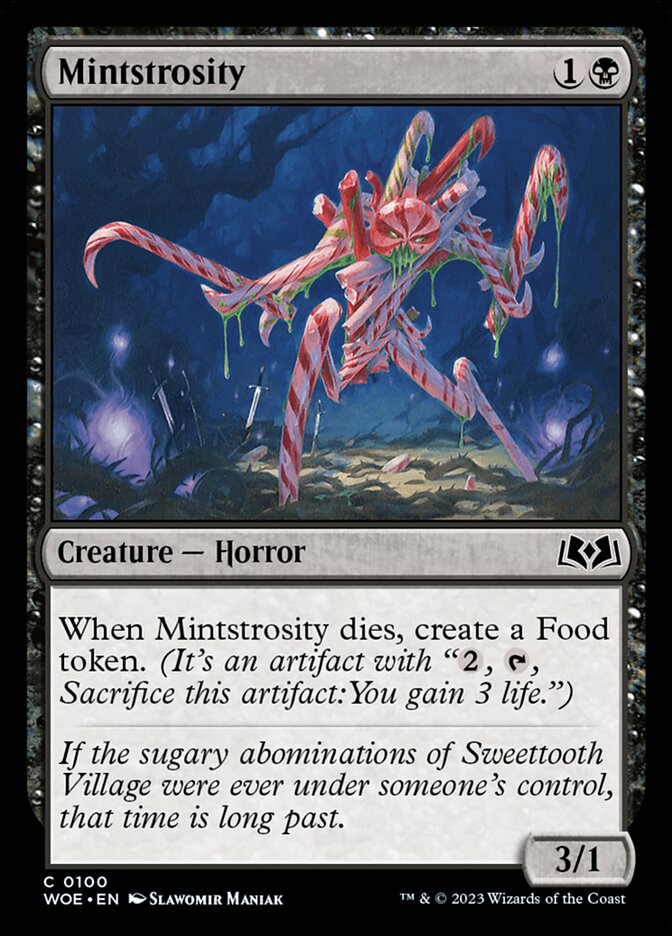
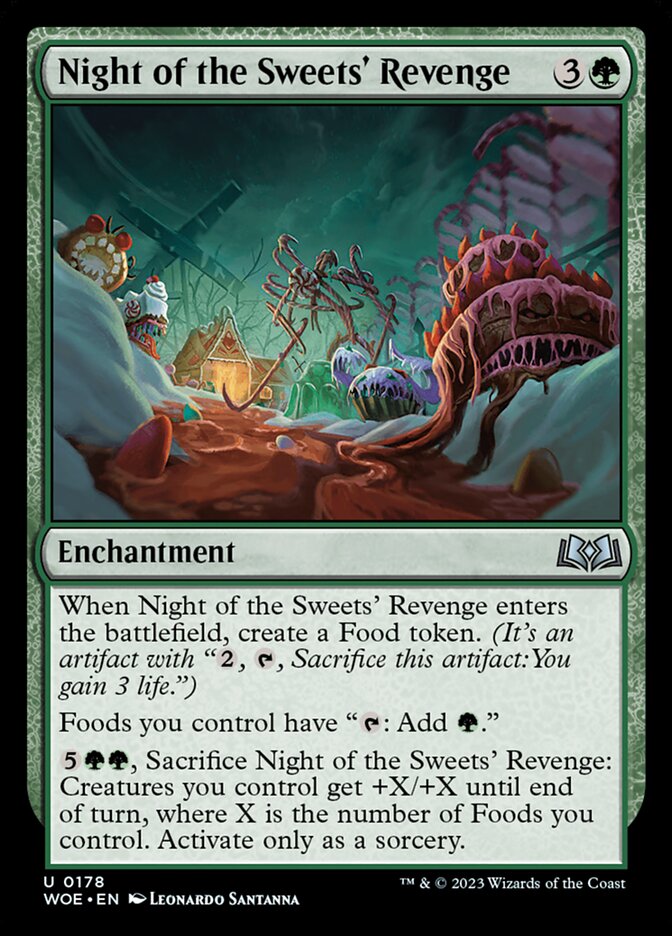
Food is a returning artifact token type that was introduced in Throne of Eldraine and used in multiple sets since. It fulfills a variety of roles: an extra permanent for Celebration, an expendable token for Bargain, or simply some life gain. Food can be created in a variety of ways, such as Mintstrosity’s death trigger. There are also some cards that specifically use Food as a resource for other effects, with Night of the Sweets’ Revenge being notable for its flexibility.
In WOE, Food creation effects are limited to Black and Green.
Enchanting Tales
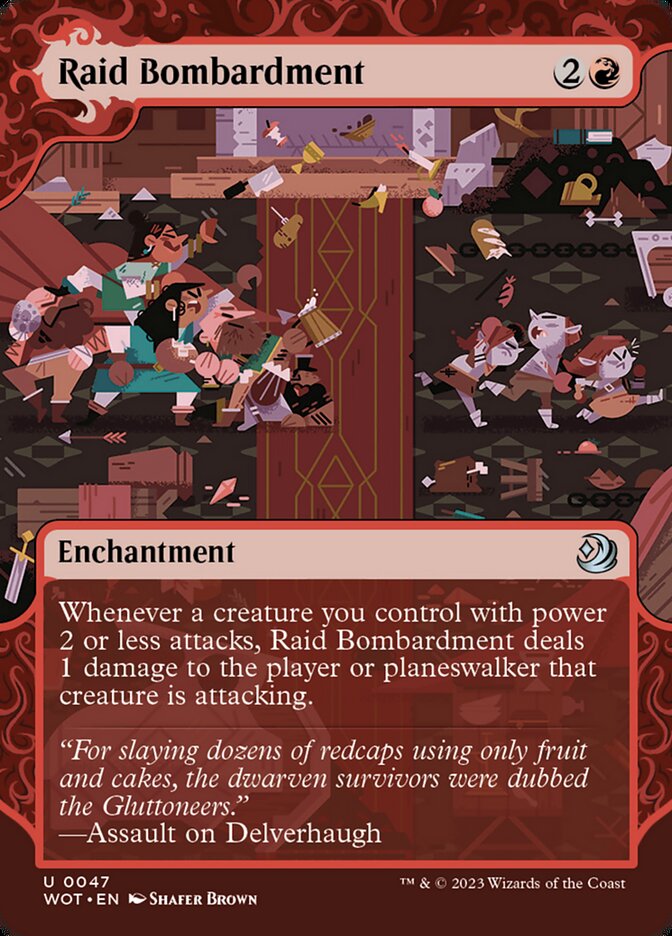

I should mention that - similarly to Strixhaven - WOE has a bonus sheet. Except this bonus sheet consists exclusively of enchantments, and there is one “Enchanting Tale” in every pack. What’s more, these bonus enchantments are specifically curated to support existing Limited strategies. For example, Rapid Bombardment is incredible in an aggro deck, while Blind Obedience is painfully good in a grindy White/Black deck. So expect to see lots of these enchantments running around, and maybe do your best to grab some enchantment if you can.
Archetypes
In WOE, each color pair has a signature uncommon Legendary creature. In addition there’s a cycle of uncommon Adventure cards that feature each color pair, although each of these can be played in a deck that only plays one of those two colors.
White / Blue: Tap Tap Tap
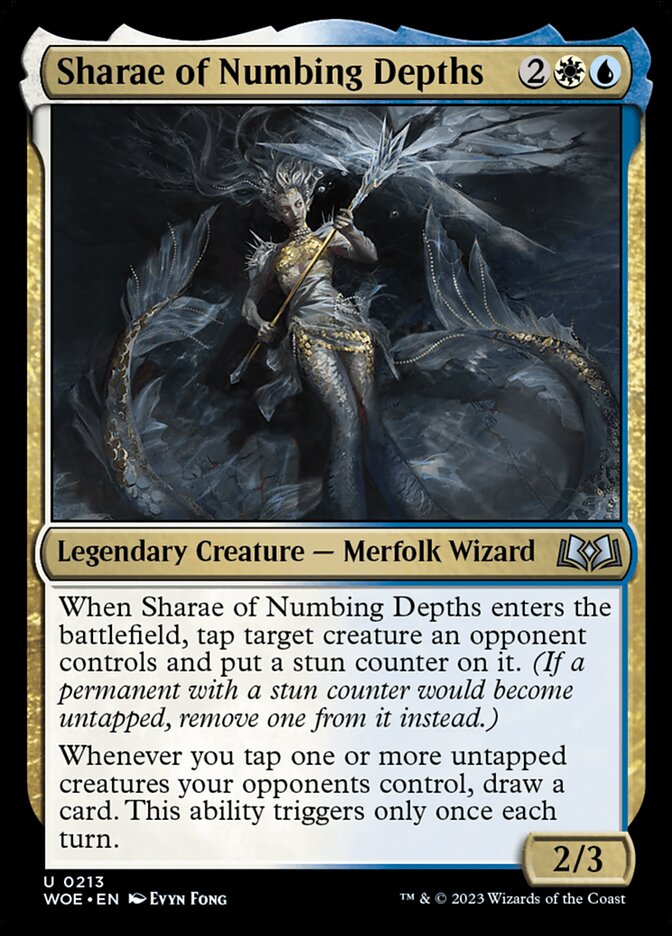
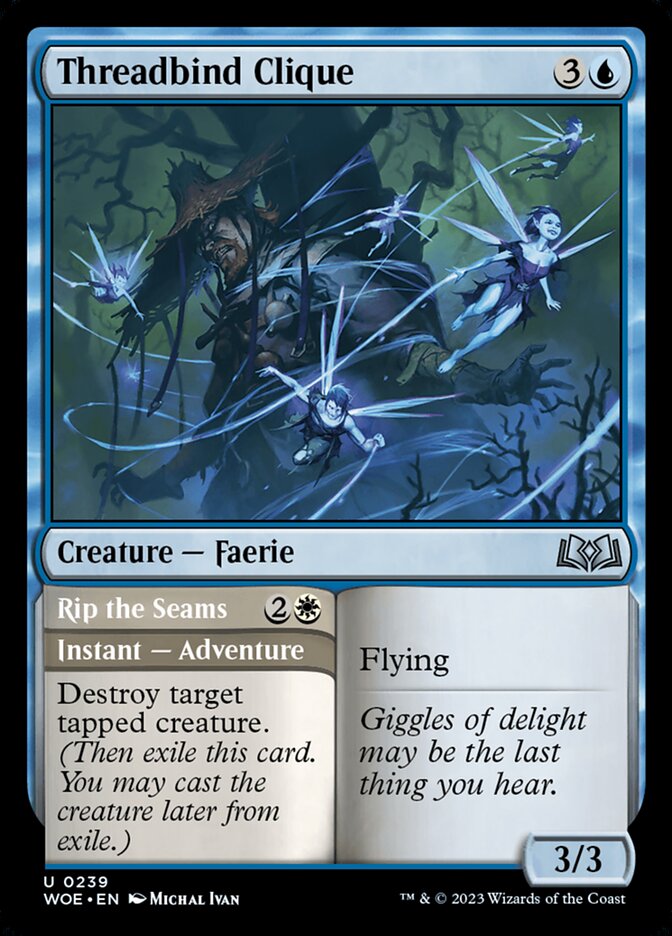
Everyone knows that White/Blue is the annoying color pair, but it’s rare that a set just flat-out embraces that fact. Well, WOE changes that with an archetype that aims to tap your opponent’s untapped creatures, often dumping on stun counters for an additional kick in the pants. What’s the payoff? You get to control the battlefield - and beyond that, cards like Sharae of Numbing Depths grant you additional rewards. Threadbind Clique // Rip the Seams adds support in a different direction, giving you both a removal spell and an evasive threat to end the game with.
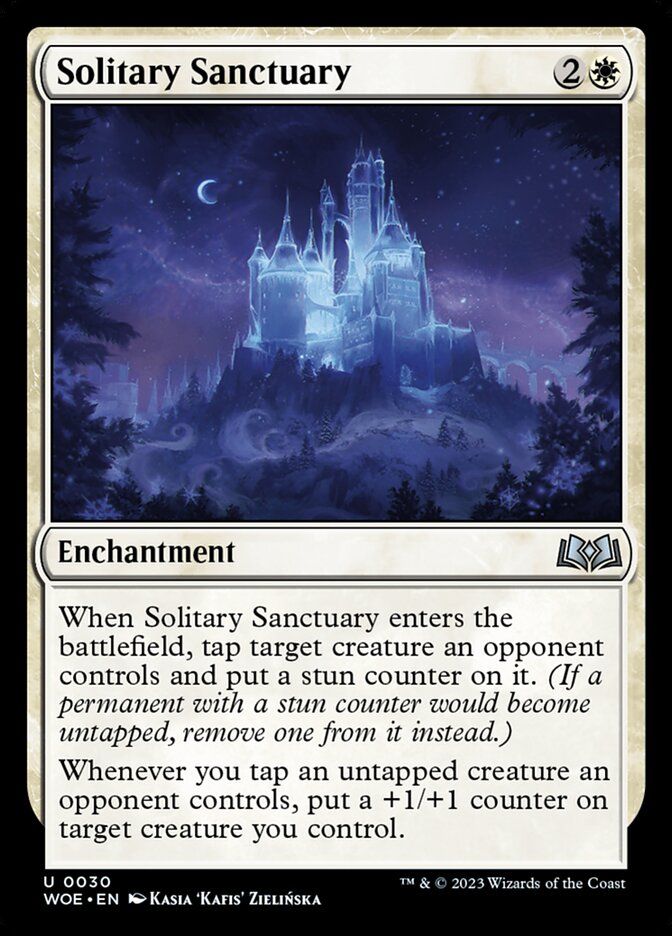
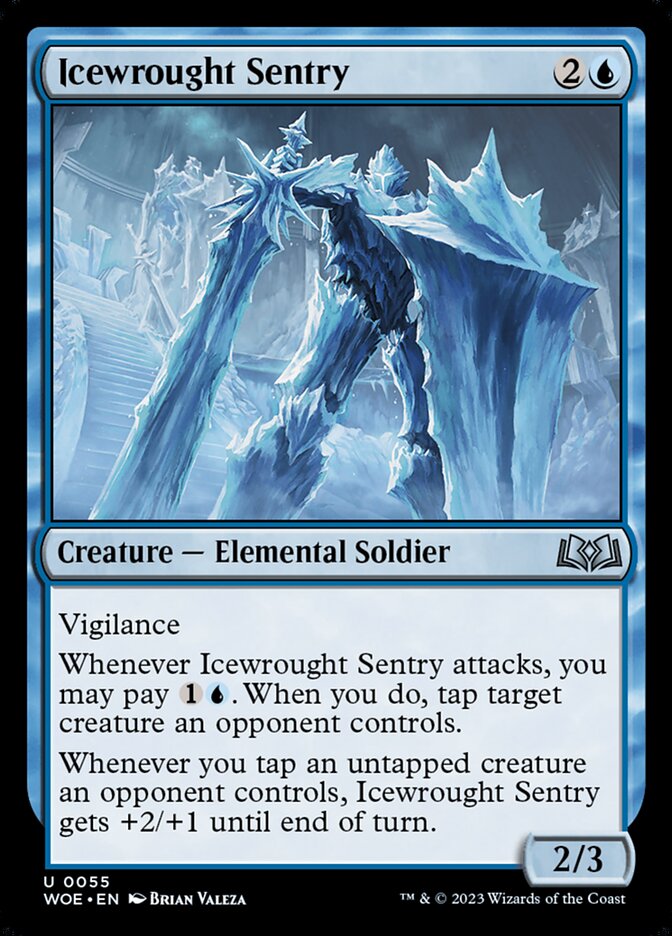
Of course you’ll want more cards to tap your opponent’s creatures with, and I suspect that may often be enough to win games. But if you want to really put the screws to your opponent, you’ll want additional payoffs. For that reason you’ll want cards like Solitary Sanctuary and Icewrought Sentry that act as both enabler and payoffs, letting you win before your opponent can recover from your flurry of tap spells.
White / Black: Enchantment Sacrifice
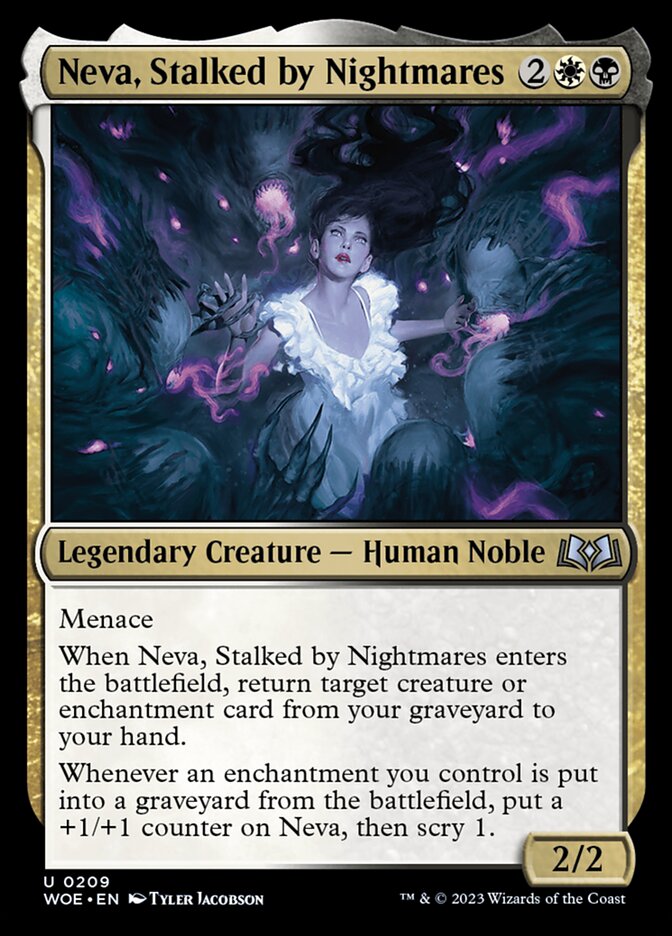

There’s something bizarrely specific about an archetype that cares about putting your own enchantments into the graveyard. But Magic is all about the new and different and WOE (and its Bargain mechanic and its plethora of Role tokens) is the perfect set for such a theme. Neva, Stalked by Nightmares is an example of a card which benefits from your enchantments’ destruction, while also giving you a way to reuse non-token creatures or enchantments. On the other hand, Shrouded Shepherd // Cleave Shadows has nothing to do with the archetype; however it has everything to do with how White/Black wants to control the game, sweeping away early threats and gaining incremental advantage with small buffs.

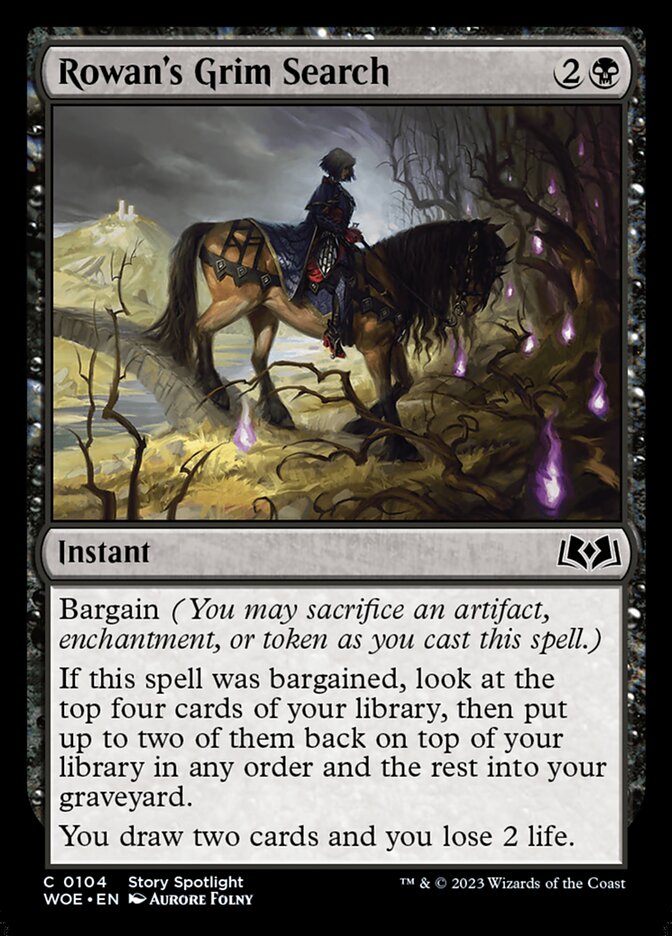
There are other ways for the color pair to creep to victory. Cursed Courtier is a three mana 3/3 with lifelink and a rather sizable drawback. But combine it with a Bargain spell like Rowan’s Grim Search, and you’ll get rid of that drawback while getting full benefit from the draw spell. Combos like these will allow you to slowly but steadily eke out an advantage until your opponent is pressured into oblivion.
Blue / Black: Faeries
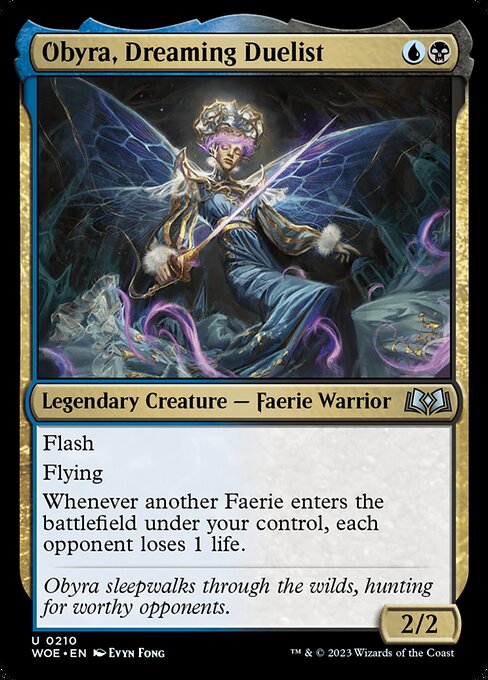

If you like faeries, then Blue/Black is the archetype for you. But what exactly do faeries do? Obyra, Dreaming Duelist illustrates the strategy well: use small evasive creatures, instant-speed tricks, and small but persistent pings of damage that wear your opponent out. Spellscorn Coven // Take It Back illustrates the strategy even better, with an annoying instant that pushes your opponent back a turn followed by a (relatively) small flier that acts as both a threat and relative card advantage.

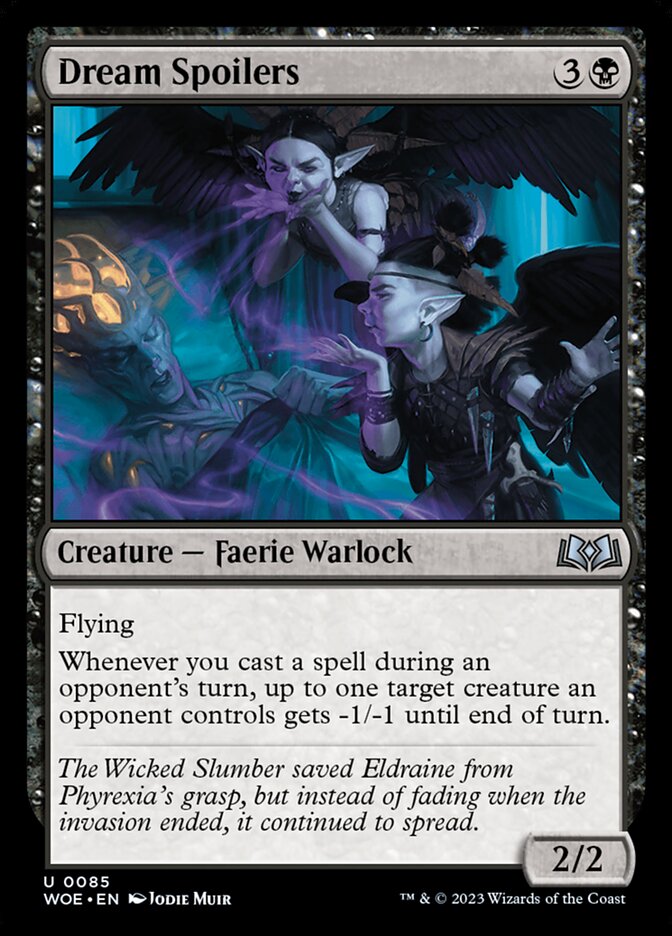
Other fun tricks include Dream Spoilers, a creature that can pick off small creatures or give you a surprise combat victory; and Spell Stutter, an easy to cast conditional counterspell that may be extremely difficult for your opponent to dodge. The faerie deck may not be one for quick victories. But it’s perfect for players who combine a few small threats with a plethora of instants and sorceries to frustrate your opponents to death.
Blue / Red: Instants and Sorceries
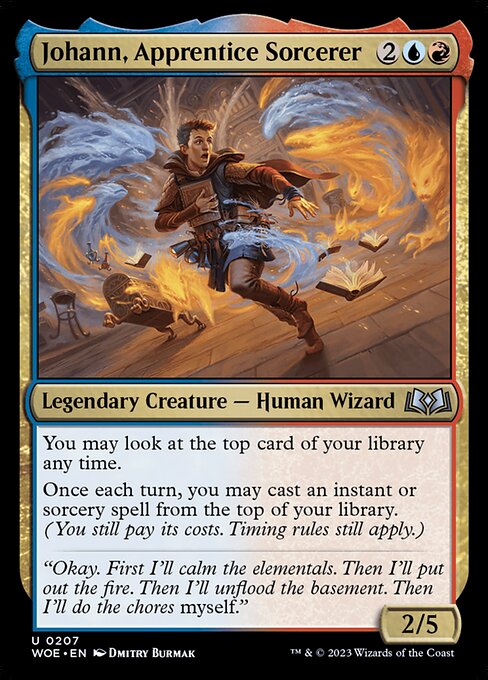

Well, not every WOE archetype can be fresh and new. “Instants and sorceries matter” returns as the Blue/Red archetype, with its signature uncommon - Johann, Apprentice Sorcerer - giving you the nice trick of casting an instant or sorcery from the top of your deck. The trick, as usual, is making sure you have enough instants and sorceries while also having the creatures needed to survive a Limited game. Adventures such as Frolicking Familiar // Blow Off Steam are excellent solutions: single cards that represent both an instant/sorcery and a creature.
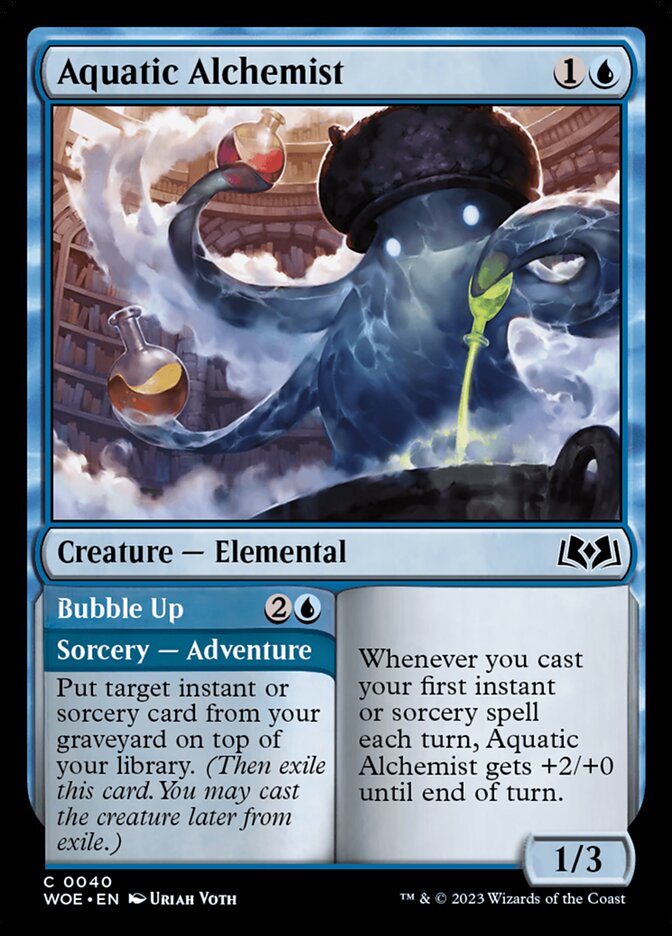
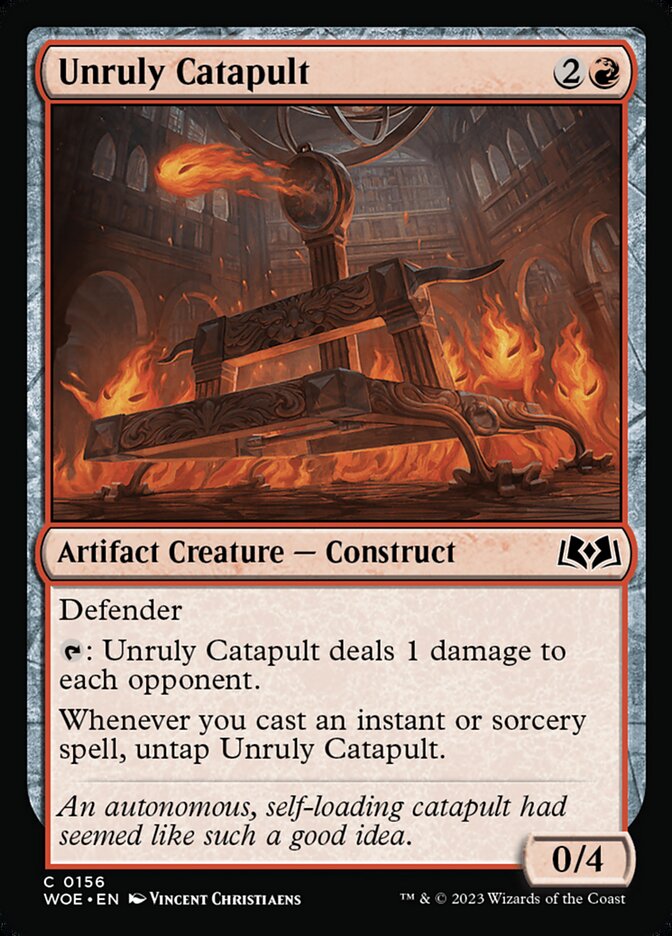
This archetype expects to win games through regular instant or sorcery casts (perhaps assisted by Bubble Up) that give you useful buffs. For example, you can get unexpectedly aggressive in the early game with Aquatic Alchemist. Better yet, you can drop down Unruly Catapult and continually ping your opponent while also neutering any early game attackers. Do this long enough, and you’ll frustrate your opponent with a strategy for victory that they may not be ready to deal with.
Black / Red: Oh, Rats
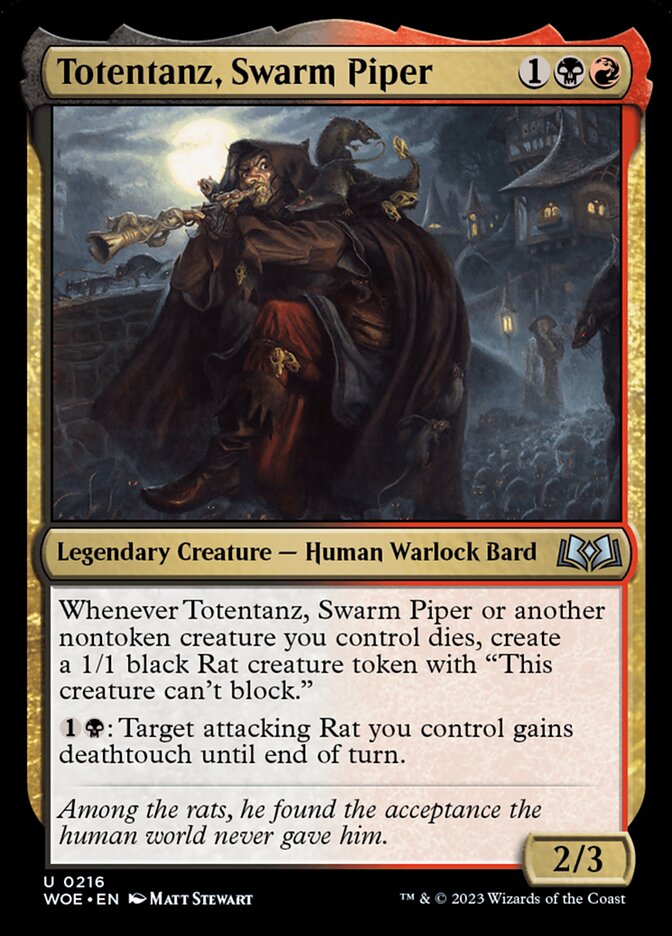
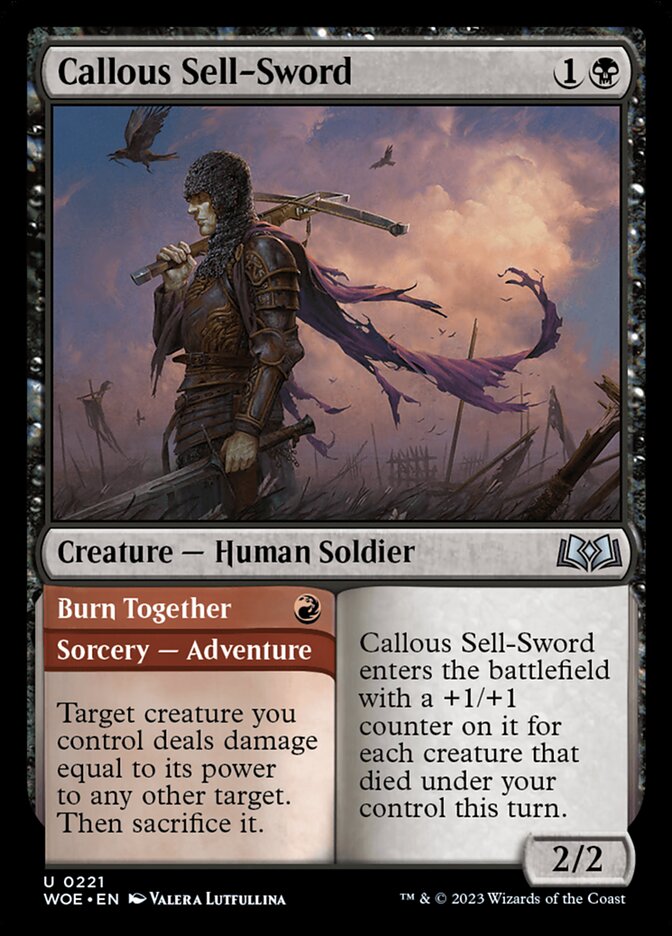
Here’s a new one: a Rat archetype. Totentanz, Swarm Piper both creates Rats and makes them deadly little threats. A Rat token is a 1/1 that can’t block, so this archetype wants to attack - perhaps with a backup plan of sacrificing creatures using Bargain spells. Callous Sell-Sword // Burn Together extends the reach of this archetype with a fling effect coupled with a creature that can be quite big, especially considering its low cost of two mana.
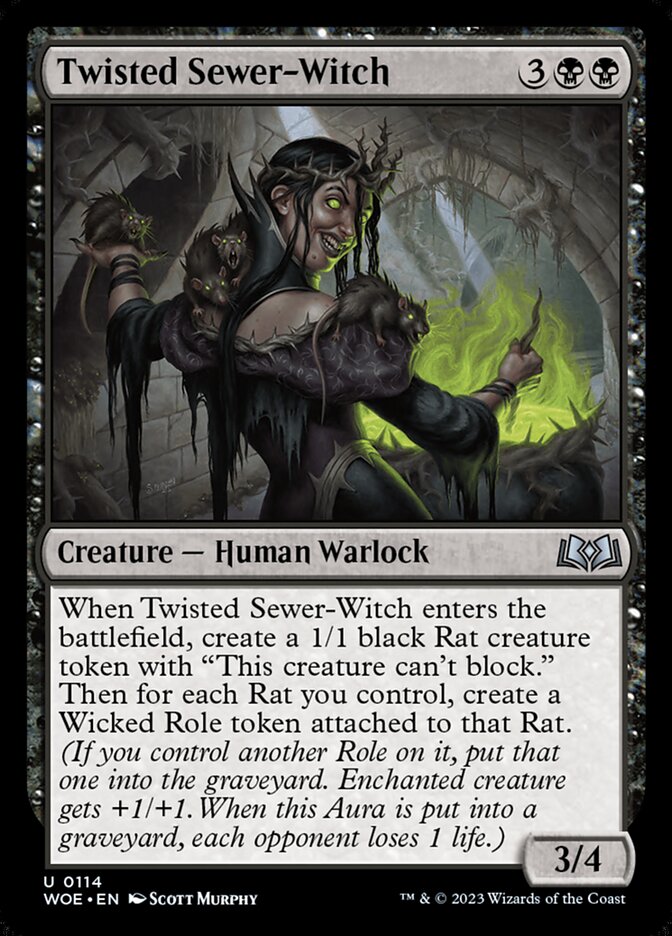
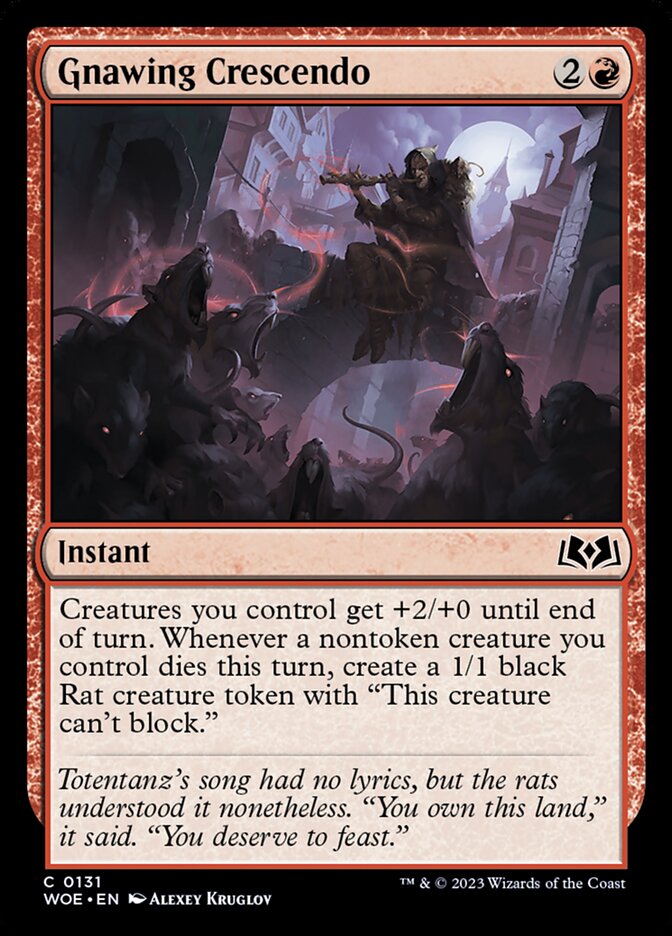
There are plenty of spells that generate Rats, but an army of 1/1 tokens may not be enough to push through an opponent’s defenses. That’s why you also wants cards like Twisted Sewer-Witch to double your Rats’ power while giving them a potentially lethal death trigger; or Gnawing Crescendo to force through an attack that leaves your opponent irrevocably behind on the board.
Black / Green: Food
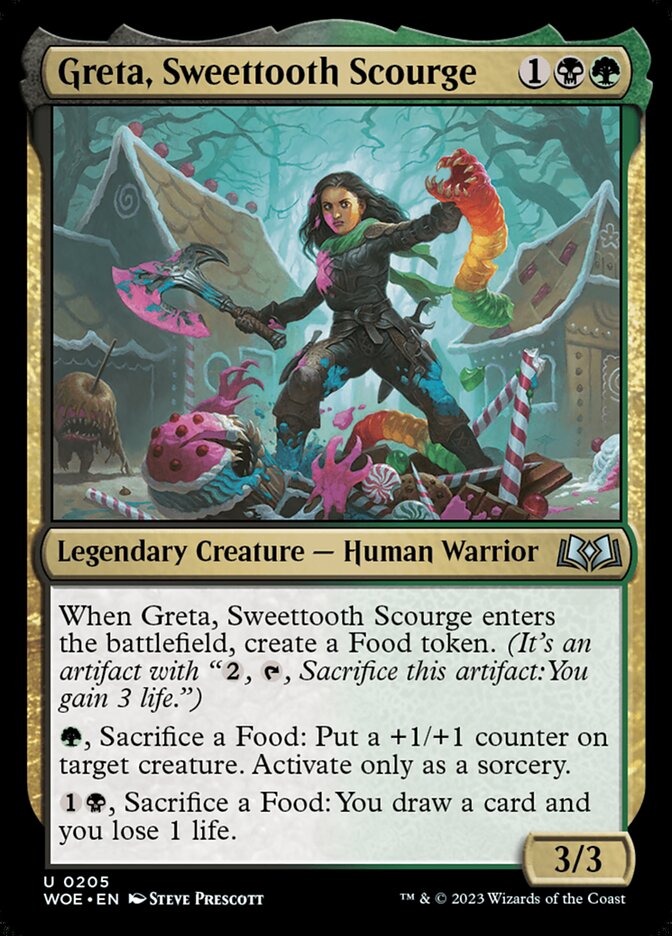

Food fight! If you think Food is just for eating and gaining life, Gretta, Sweettooth Scourge is here to show you the error of your ways. By herself she enables Food to give you +1/+1 counters and card draw. Note that this archetype can take a while to get going, so if you’re facing a pesky aggro deck, don’t be afraid to use Food for its original purpose - gaining life. Another way to protect yourself is with Gingerbread Hunter // Small Snack - an early removal spell (albeit an inefficient once) that turns into a nicely costed 5/5 creature that arrives with a Food.
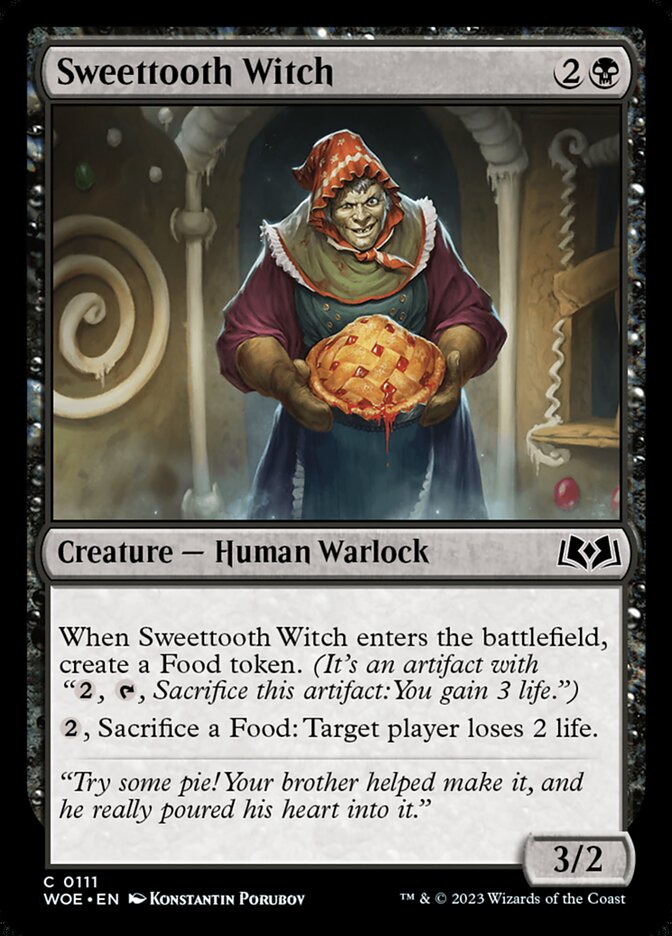

There are other ways to play with your Food. Sweettooth Witch turns Food into unavoidable bursts of damage - a perfect way to gain the upper hand in a board stall. And Tough Cookie is an amazing two drop that actually creates two Food while granting you an ability that allows you to attack for six on turn 3. There’s a ton of flexibility in this archetype, and if you survive long enough you’ll have all the tools you need to win through any situation.
Red / White: (Aggro) Celebration!
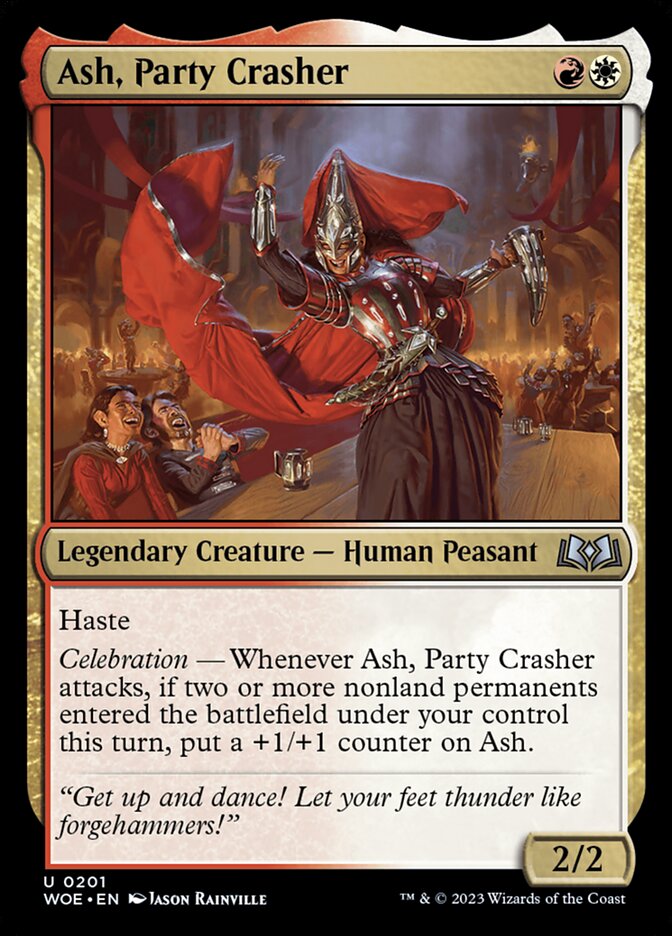
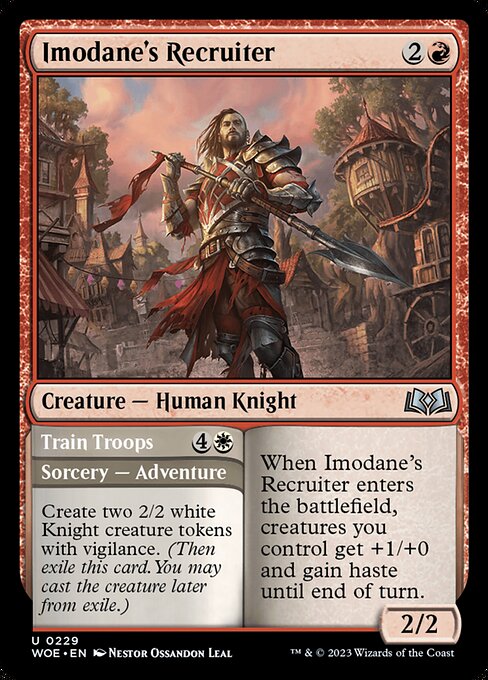
There’s nothing subtle about Red/White here. Ash, Party Crasher wants you to celebrate now, and later, and forever - well, until your opponent runs out of life. And the best way to celebrate? Lots of cheap permanents, and lots of attacking! Imodane’s Recruiter // Train Troops continues the festivities with an Adventure that triggers Celebration by itself and a creature that pumps everything up. It’s also an example of the choices WOE asks you to make: attack with an (effectively) hasty creature with (effectively) 3 power on turn three, or wait until later to derive full value from the Adventure card.
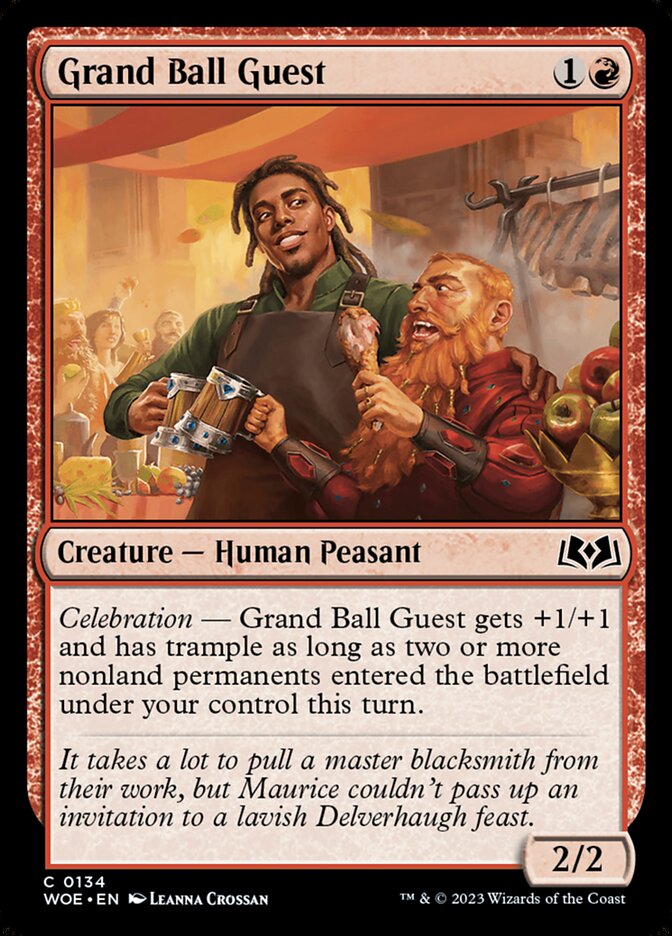
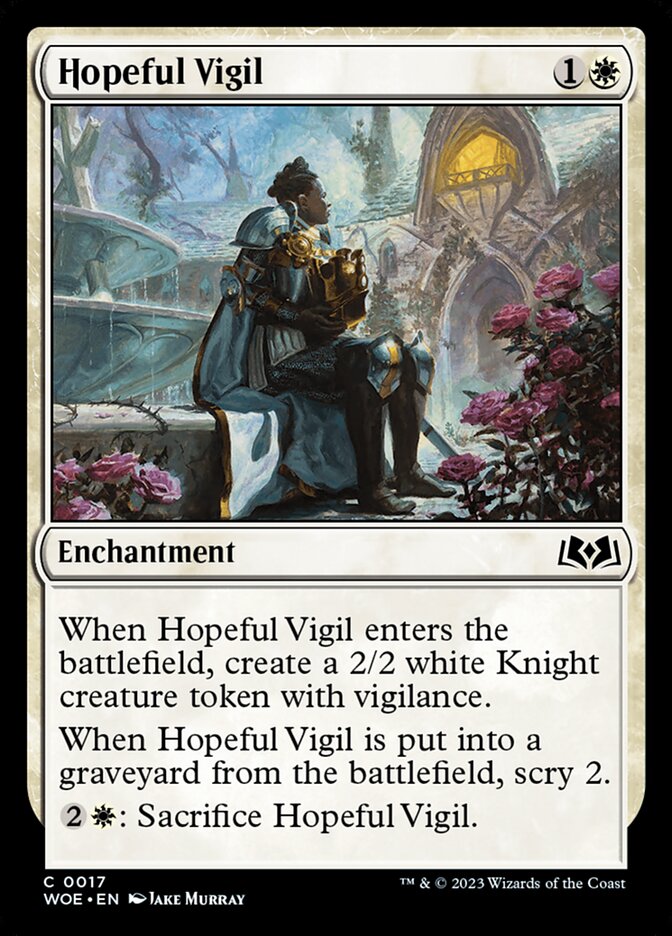
That’s basically all you need to know about this archetype. Mix creatures with Celebration triggers (such as the awesomely aggressive Grand Ball Guest) with spells that trigger Celebration by themselves (such as Hopeful Vigil) and attack and attack and attack until someone - hopefully your opponent - is at zero life.
Red / Green: Power 4 Matters

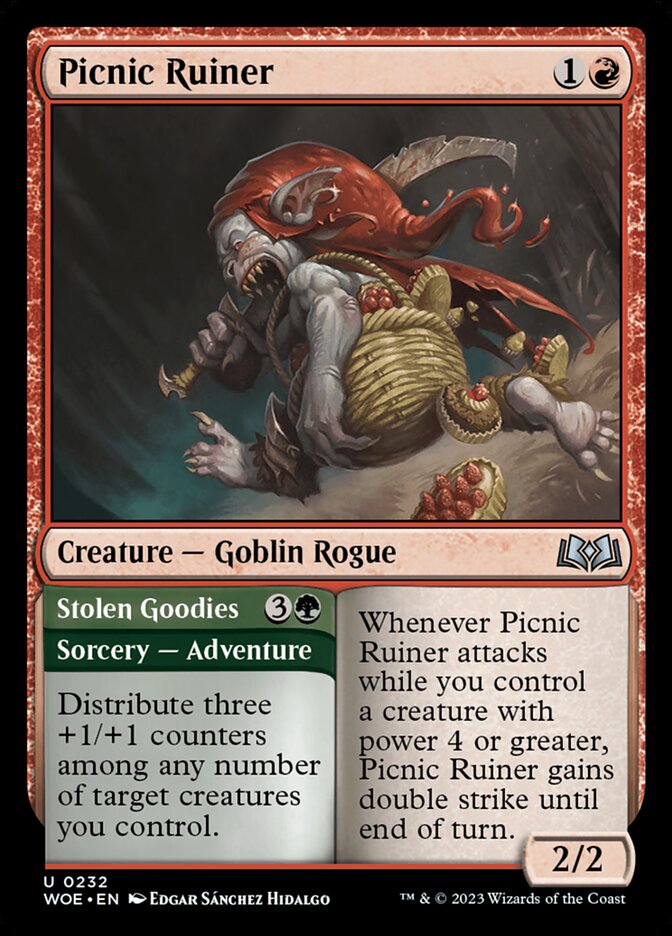
Creatures with high power usually cost more, which begs the question of what an ideal low drop for such an archetype might look like. Well, it might look like Ruby, Daring Tracker: a two drop mana dork that ramps out your big threats, and who also becomes a credible attacker in the midgame. The color pair’s uncommon Adventure spell also supports the theme, with a creature that gains an important bonus if it attacks with a creature with power 4 or greater, and a buff spell that may put combat out of reach for your opponent. Note that the Adventure half of the spell is more expensive than the creature half, meaning you may have to make some interesting choices regarding how to cast Picnic Ruiner // Stolen Goodies.

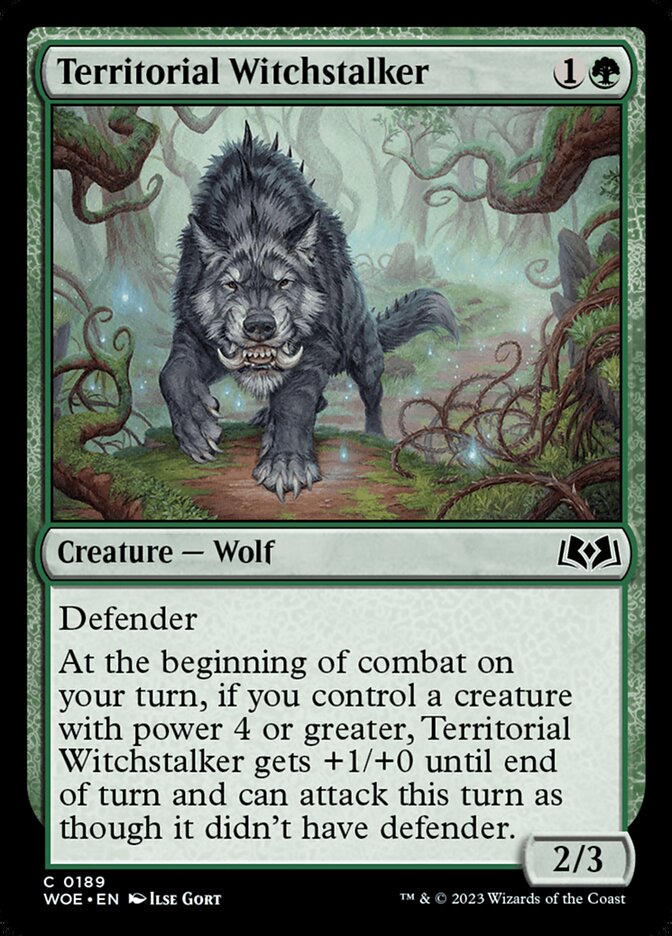
It’s easy to identify creatures with 4 power (some which cost as little as three mana), so let’s focus on other payoffs for achieving that threshold. Boundary Lands Ranger and Territorial Witchstalker are both coveted two drops that not only provide early board presence; they also transition nicely into the midgame once you play a 4 power creature, with Boundary Lands Ranger allowing you to filter through your deck for what you need and Territorial Witchstalker simply becoming an efficiently costed attacker. There’s nothing especially tricky about smashing with Red/Green - but that’s the charm of the archetype.
Green / White: Auras
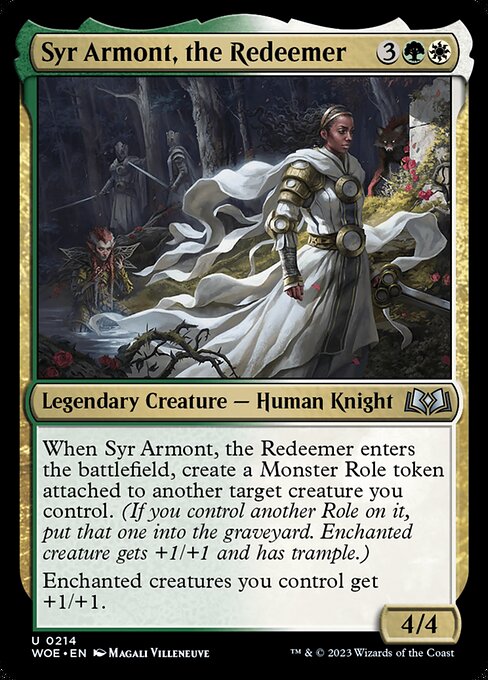
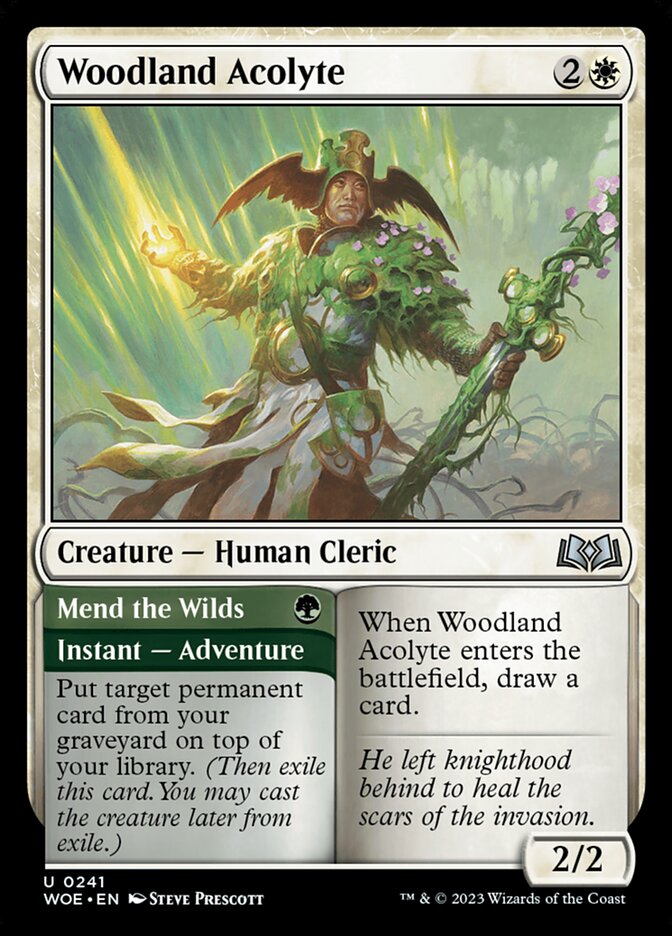
Normally an Auras archetype might feel a bit niche, but not in WOE. This makes Green/White both straightforward and powerful: by the time you drop Syr Armont, the Redeemer, you’ll hopefully already have a field full of creatures and Roles, making combat untenable for your opponent. Woodland Acolyte // Mend the Wilds is another example of a support uncommon that doesn’t directly support the archetype, but supports the overall strategy by giving both resilience and card advantage to a color pair that can lack in both.
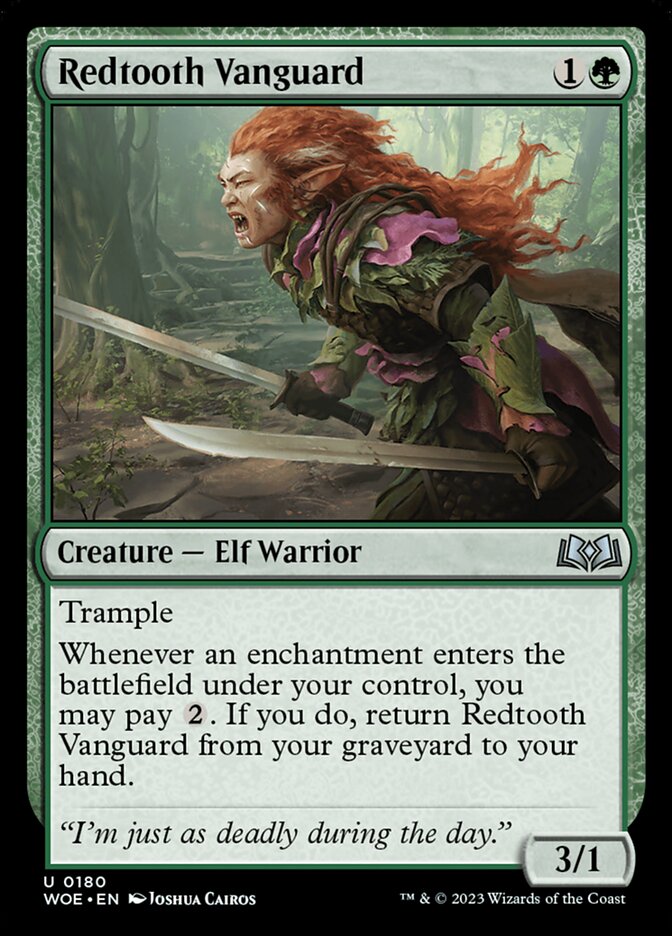
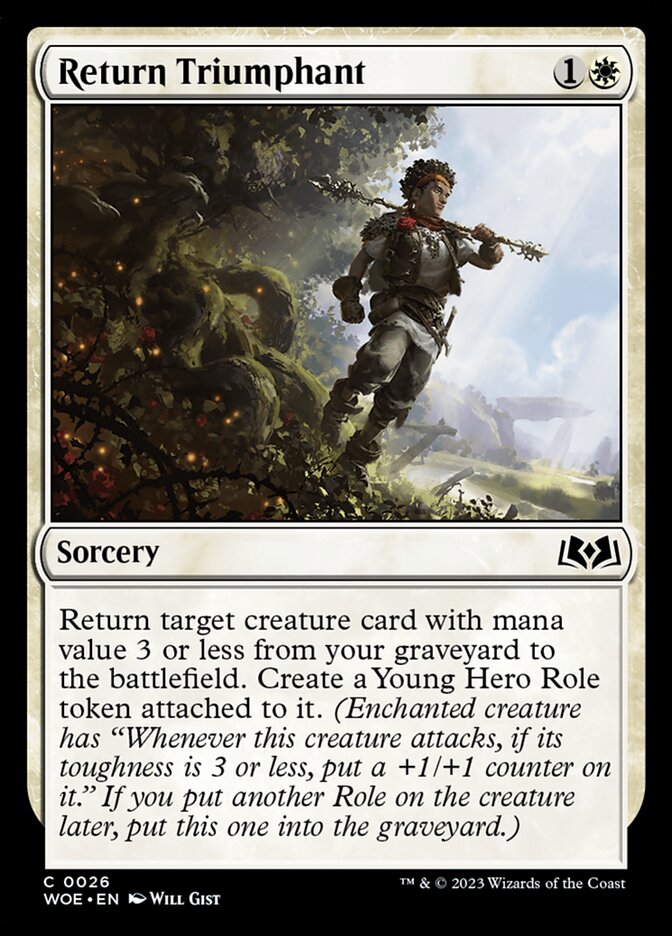
Needless to say, you’ll be looking for Auras and cards that create Roles. But what else? Well, combat focused archetypes can always benefit from a little resilience, and that’s what Redtooth Vanguard gives you: an aggressive two drop that has the capability to keep coming back. Return Triumphant performs a similar function, with the added bonus of creating a Role. Persistence is often the key to a deck like this: last long enough and you’ll beat down any opponent.
Green / Blue: 5+ Mana Value
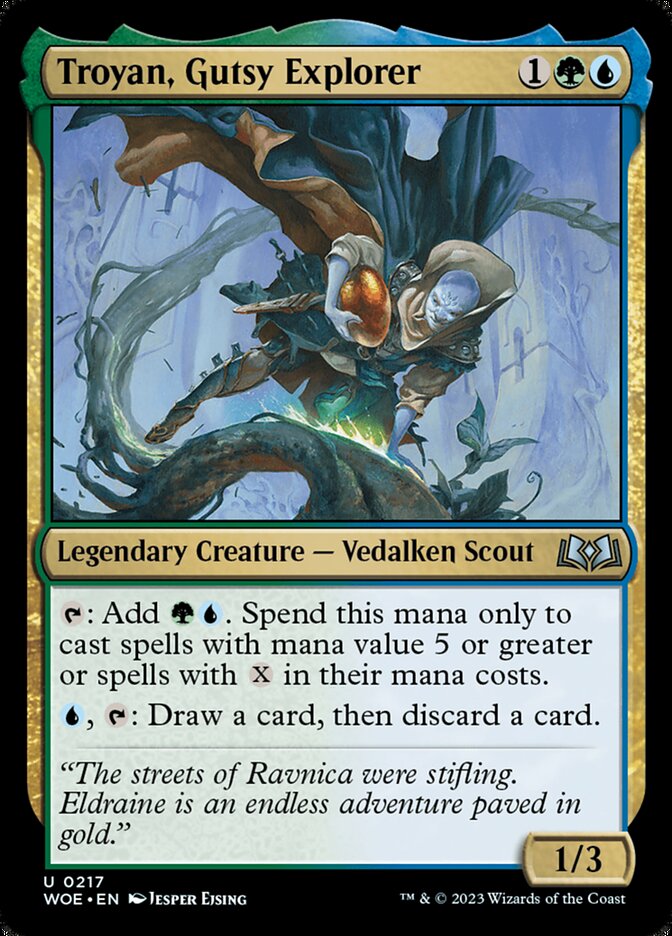

If you’re comforted by the familiar, then you’re in luck with WOE’s Green/Blue archetype: ramp. Troyan, Gutsy Explorer does a lot of good things here by tapping for two mana for your big spells, while allowing you to loot away your cheap spells when you no longer need them (or to throw away your expensive ones if you’re desperately scrambling for some early action). Tempest Hart // Scan the Clouds is similar, with the Adventure half allowing you to filter your hand for cheap spells or expensive spells as the situation demands, and the creature half acting as a payoff for casting your 5+ cmc spells.
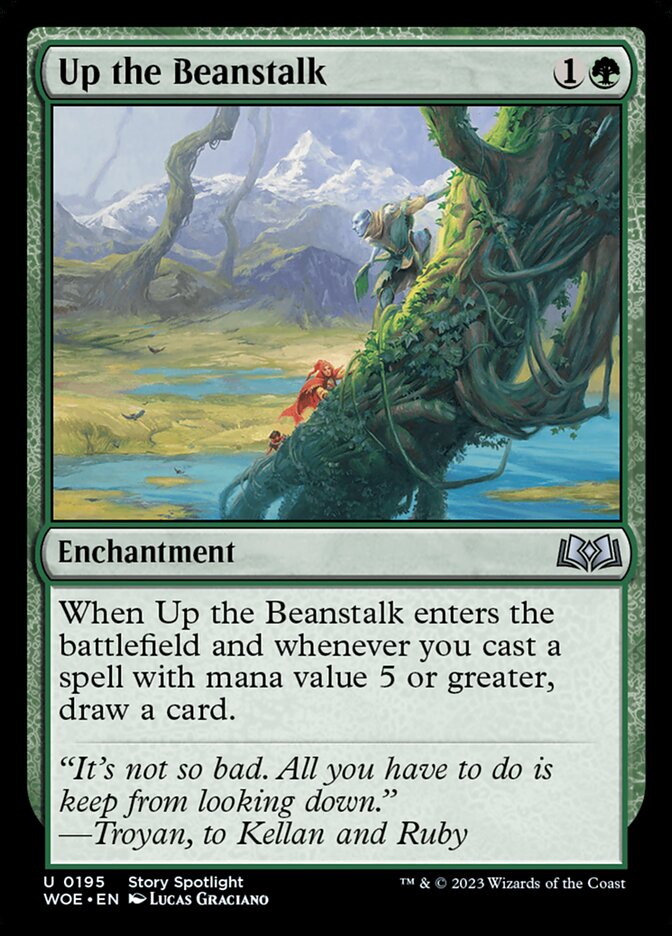
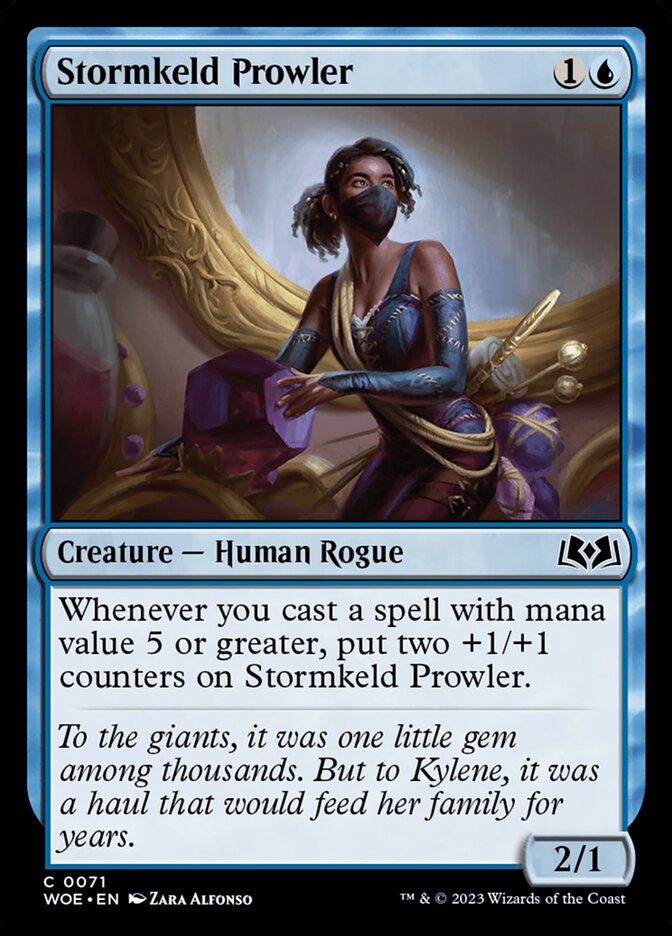
Once again, it’s not hard to realize that an archetype that cares about spells with 5+ mana value should grab cards with 5+ mana value. So let’s highlight a few more payoffs. Up the Beanstalk is a nice one, immediately replacing itself while feeding you cards in the late game. Stormkeld Prowler is less flashy, but may actually prove to be more critical for Green/Blue decks. Why? It’s an all-important two drop that gives you early board presence while also providing an impact once you reach the five mana threshold. Maintaining that balance between the early game and the late is key to making this archetype work.
Mana Fixing
Mana fixing feels pretty reasonable at common and uncommon. I wouldn’t hesitate to try and splash bombs or removal, or even the off-color half of an Adventure.


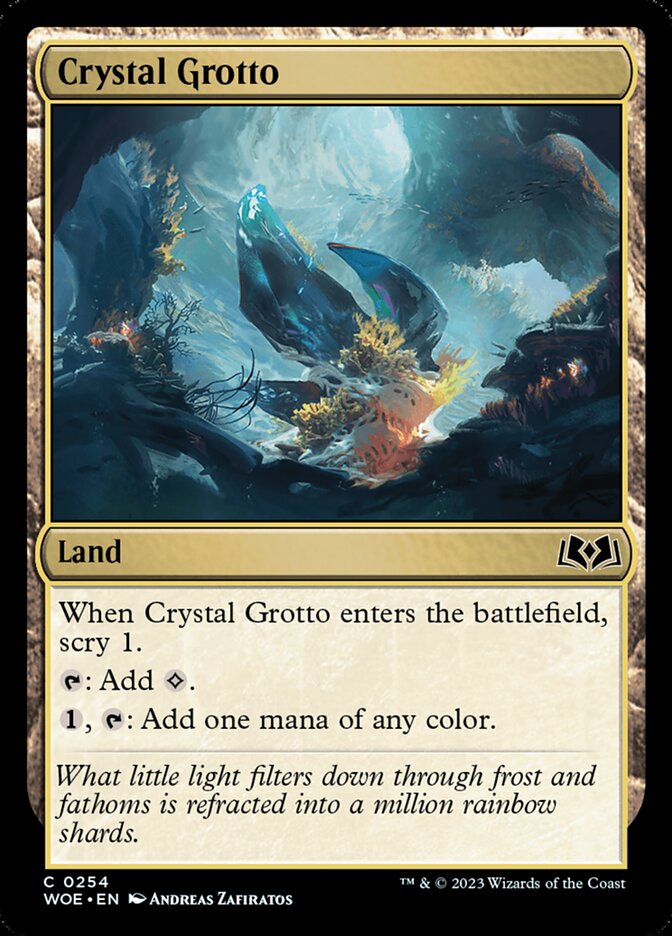


Of course Green has some additional options:

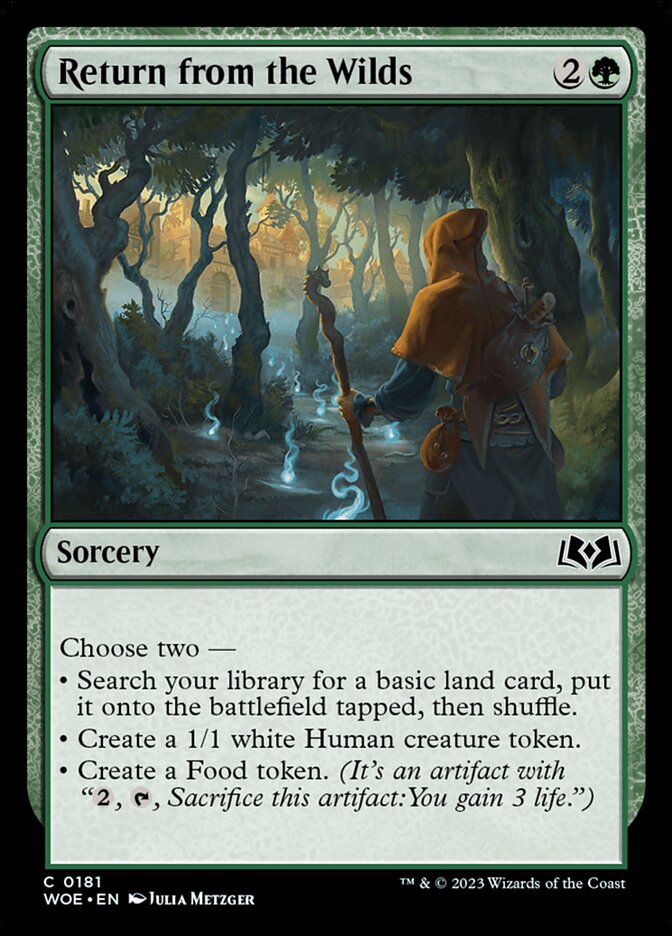

Key Commons and Uncommons
White
Creatures

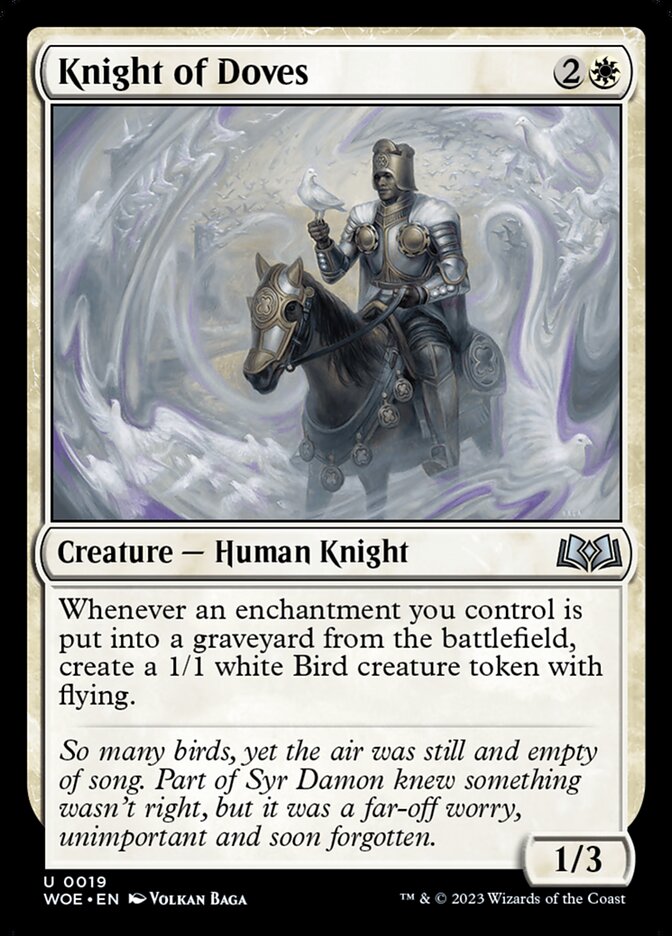

Discerning Financier: I don’t think I’ve ever wanted to be on the draw in a Draft game, but this creature makes the prospect strangely tempting.
Knight of Doves: In a set chock-full of Auras, creating a free evasive 1/1 whenever one of them goes away seems like an excellent path to victory.
Rimefur Reindeer: I can’t help but believe that this creature will enable a lot of alpha strikes.
Non-Creatures



Archon’s Glory: There’s no denying that combat tricks are risky to use. But cheap ones are always worth looking at, and cheap ones that can give you an evasive win or startle your opponent with a key block mixed with some lifegain - well, I wouldn’t be surprised if this instant turned out to be a key player in some aggressive decks.
Cooped Up: This card is actually a sneaky combination of White’s usual cheap Pacifism effect and White’s usual expensive exile effect. It gets bonus points for being an Aura in a set with a heavy enchantment theme.
Stroke of Midnight: This is a removal spell that doesn’t quiiiiiite fully remove whatever it is you’re aiming at, and that’s not always great. But giving your opponent a measly 1/1 isn’t that bad… and more importantly, this spell has incredible flexibility and hits any nonland permanent, including the pesky enchantments running rampant through the set.
Blue
Creatures
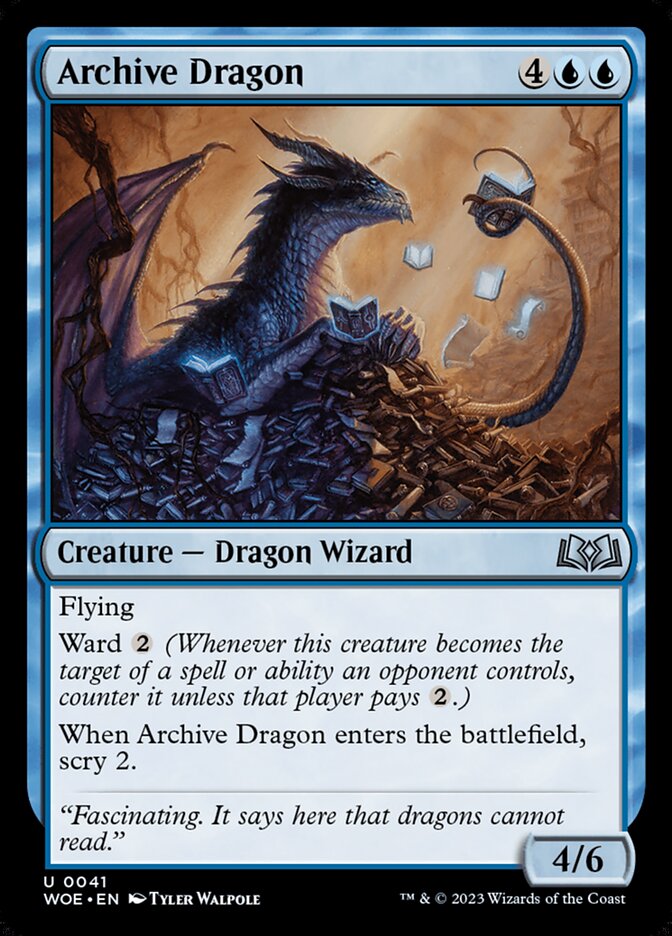
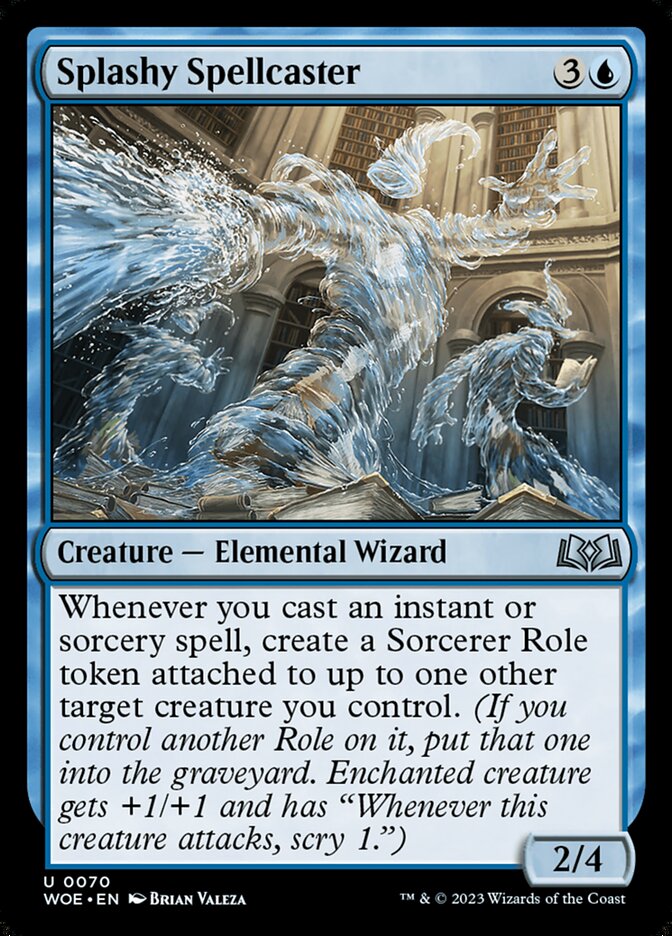
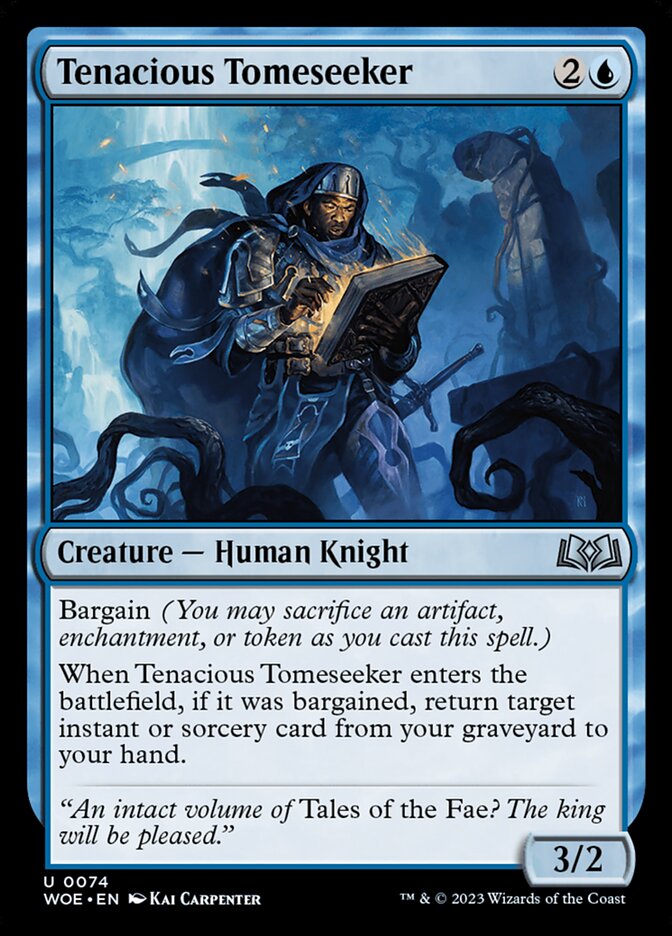
Archive Dragon: Did you know that a 4/6 flyer can win games? And it has additional upside too!
Splashy Spellcaster: Creating free Sorcerer Role tokens is good, and the potential for doing so at instant speed and screwing up combat math is great.
Tenacious Tomeseeker: The best Bargain cards are those where you don’t actually go down a card. Sacrificing a useless Role for the best instant or sorcery in your graveyard meets that criteria.
Non-Creatures
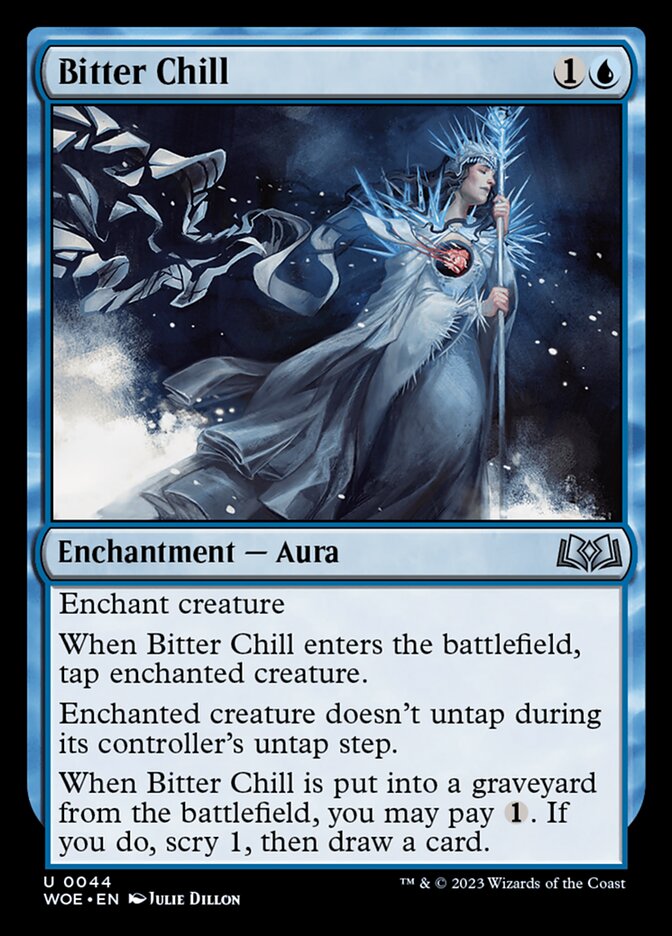
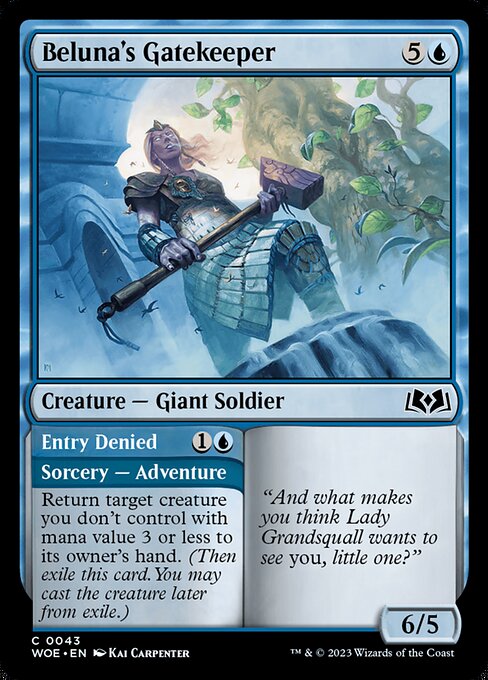
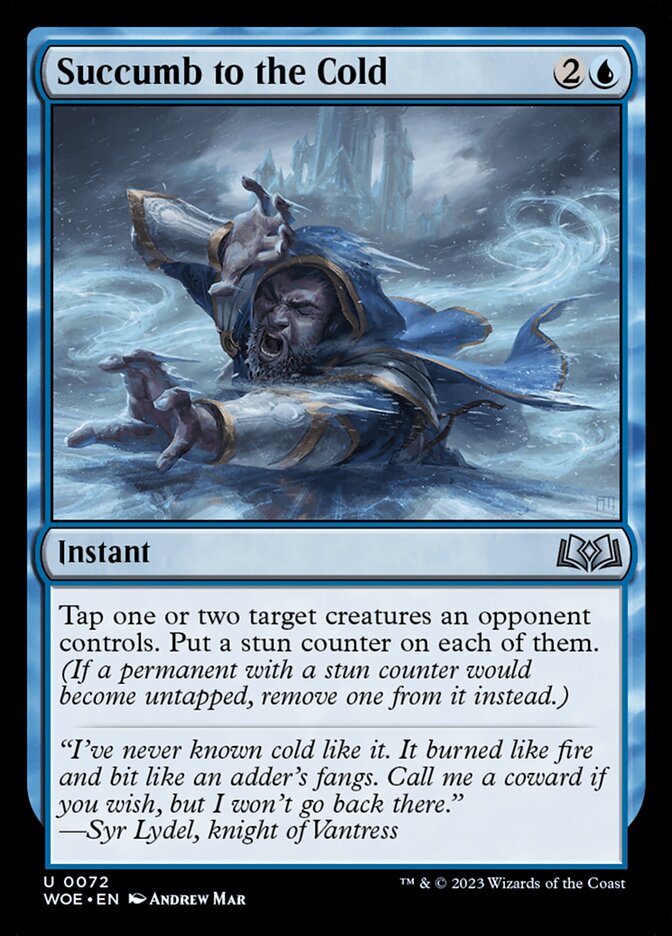
Bitter Chill: Blue Auras that tap creatures down aren’t always great. But this one is only two mana, it enables other cards that care about tapping opponents’ creatures, and it’s an enchantment in a set chock full of enchantment synergies.
Beluna’s Gatekeeper // Entry Denied: A 6/5 vanilla creature for six mana is whatever, but a two mana bounce spell - even if it has limitations - feels like it may be the key to surviving an aggressive early game and making it to the late.
Succumb to the Cold: Most tap effects in WOE are sorcery speed, making this instant speed trick stand out. And if you have cards that care about tapping opponents’ creatures, triggering those abilities at instant speed may be back breaking.
Black
Creatures

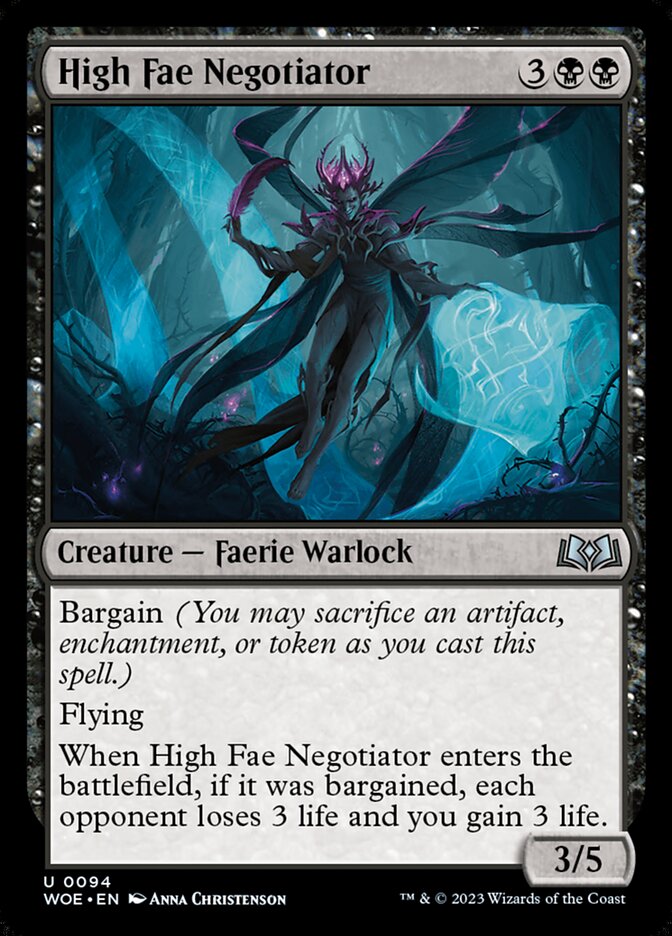

Ashiok’s Reaper: Maybe this creature takes a little work to get going, but it’s well worth the effort.
High Fae Negotiator: I have won (and lost) many games because of Vampire Sovereign. This creature isn’t exactly the same, but it’s pretty close.
Lord Skitter’s Butcher: At least one of these modes will be useful to you.
Non-Creatures
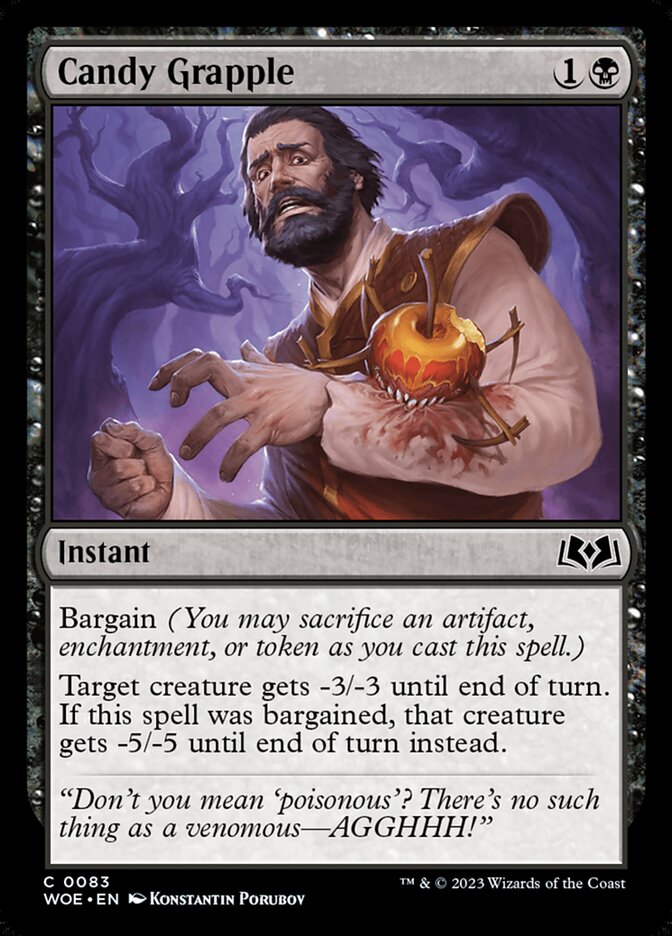


Candy Grapple: Takes out the small, and if you really need to take out a big then you’ll be glad that you have the flexibility to do so.
Faerie Fencing: If you don’t control a Faerie, then this is an instant speed scaling removal spell. If you do, then WOW.
Taken by Nightmares: Here it is: Black’s four mana unconditional removal spell. It’s good, and even better if you can pull off the scry 2 - and in this set, why wouldn’t you be able to?
Red
Creatures



Bellowing Bruiser // Beat a Path: Neither of these cards are great by themselves, but they work really well together as part of an ideal curve for an aggressive deck.
Edgewall Pack: Cards that trigger Celebration by themselves are good, and this one comes with a nicely aggressive creature.
Redcap Thief: Cards that trigger Celebration by themselves are good, and this one comes with a useful Treasure token.
Non-Creatures
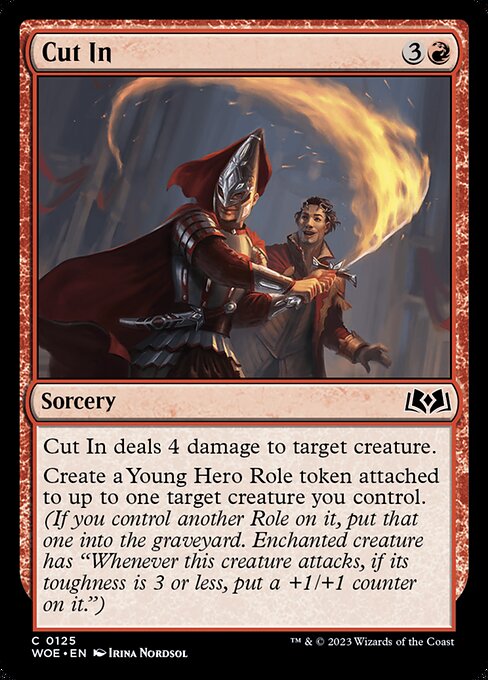
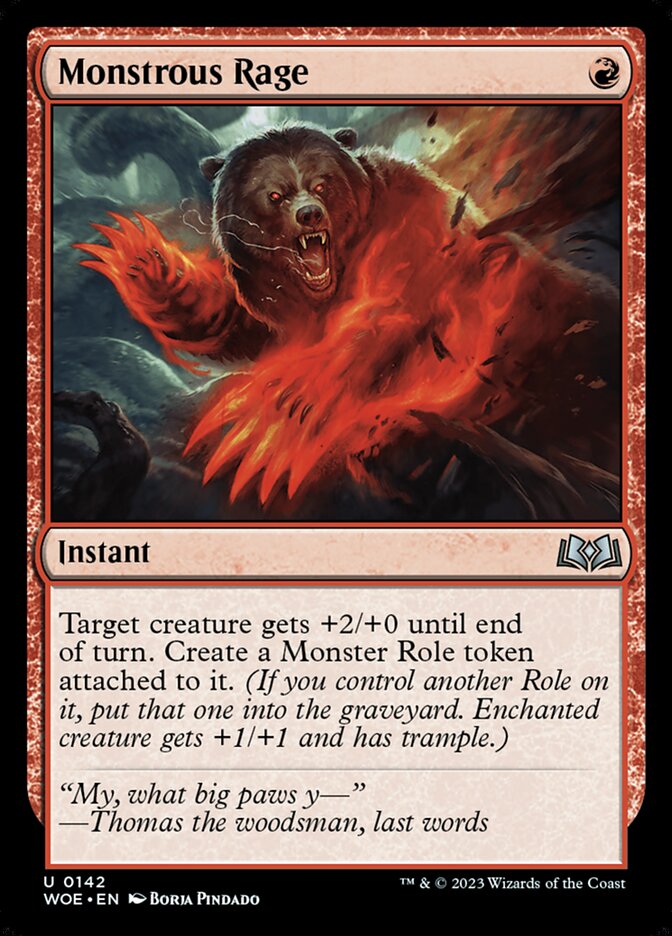
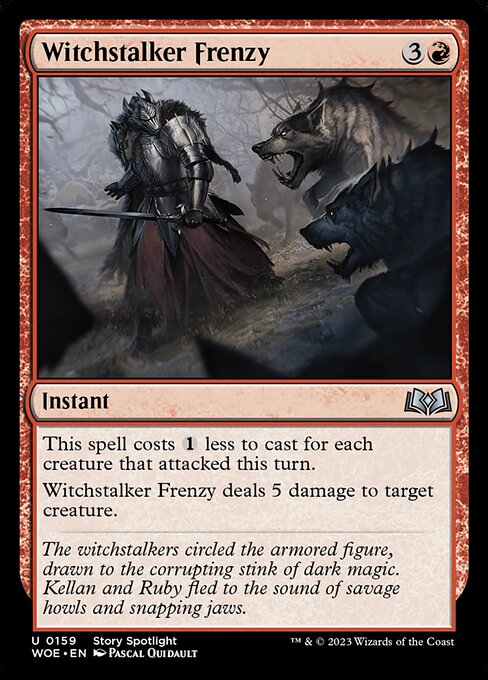
Cut In: Think of this as a curve topper that clears the way for your smaller attackers.
Monstrous Rage: Why is this card an uncommon? Because it will end games.
Witchstalker Frenzy: The cost reduction ability works for your attacking creatures or your opponent’s attacking creatures, giving this instant miraculous flexibility and power.
Green
Creatures
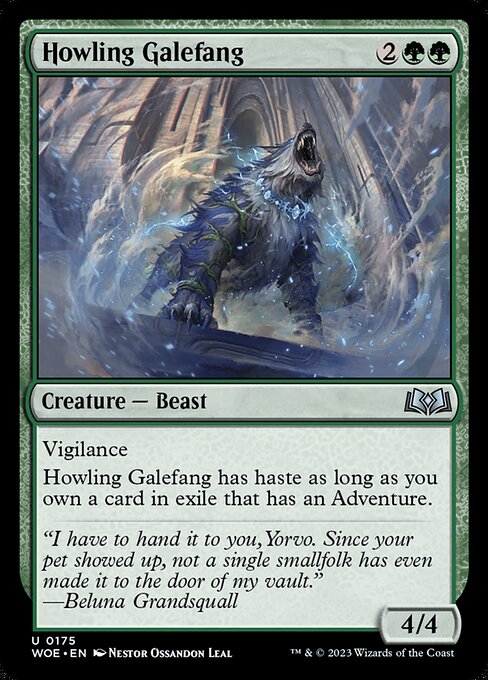
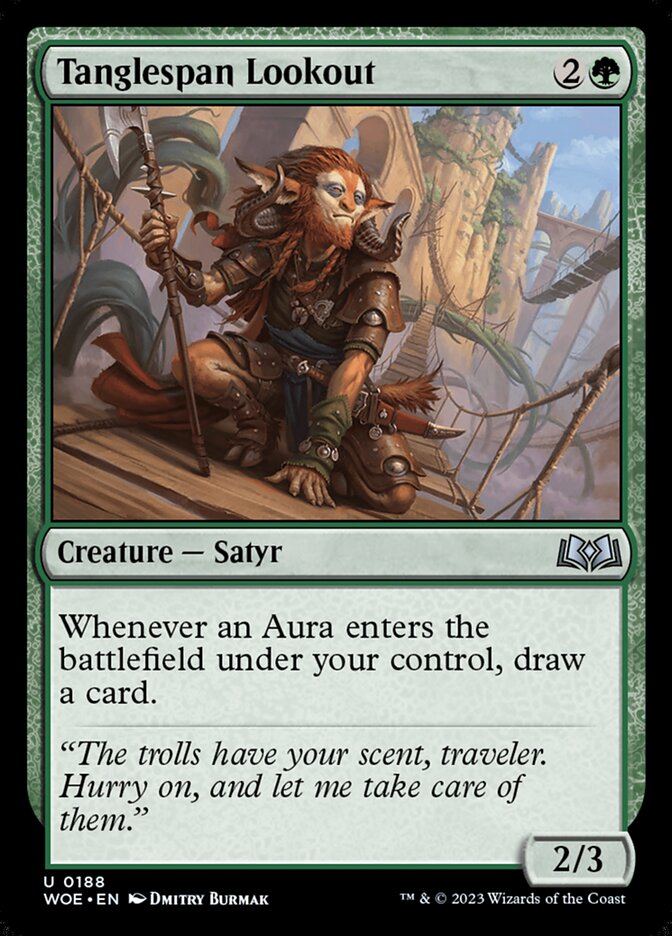
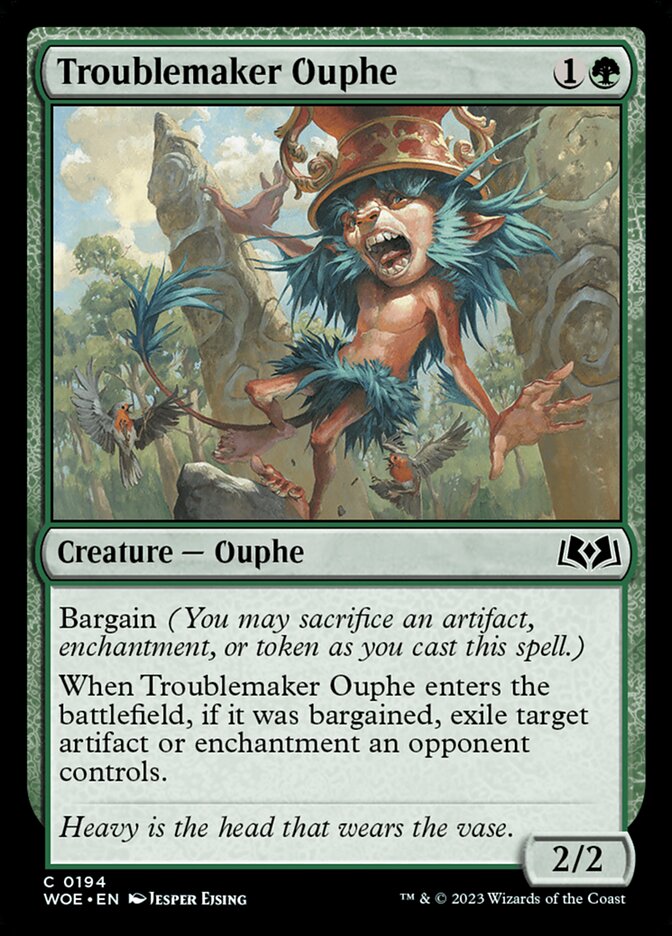
Howling Galefang: A 4/4 with vigilance is a good deal for four mana, and the possible added bonus of having haste is pure gravy.
Tanglespan Lookout: Do you like drawing cards? I like drawing cards, especially in a color that isn’t known for doing so in Limited.
Troublemaker Ouphe: Two drops are always nice in Limited, and this one can blow up your opponent’s troublesome enchantments if you draw it late.
Non-Creatures
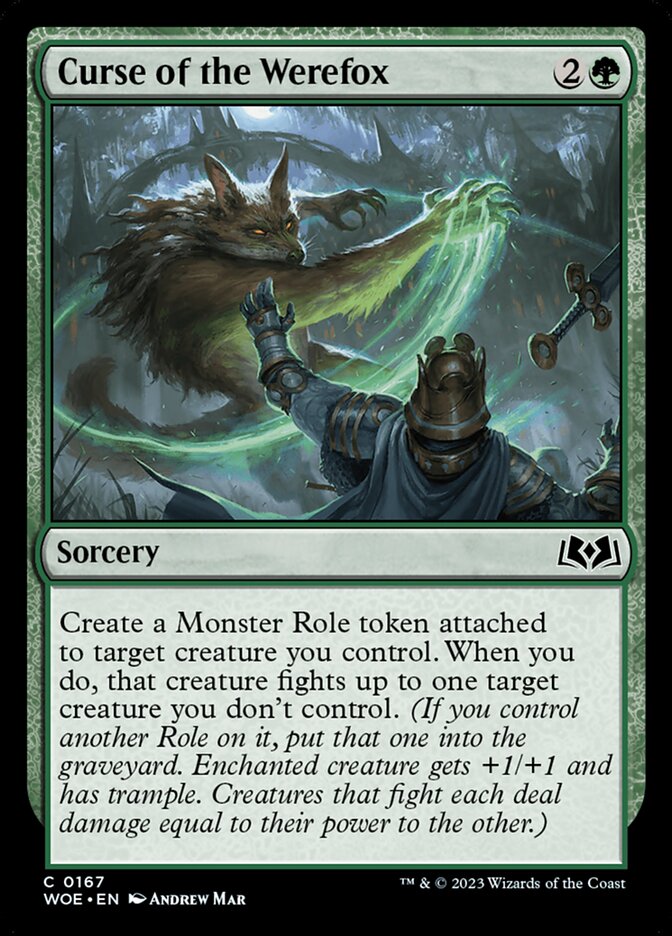

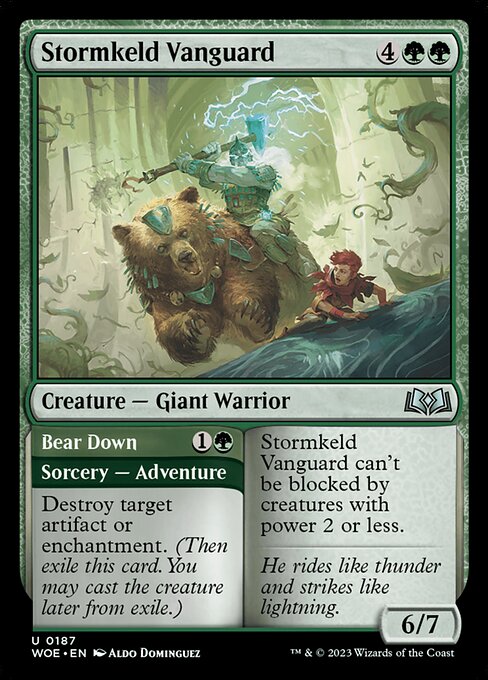
Curse of the Werefox: Why yes, I do like fight spells that come with a permanent buff.
Graceful Takedown: A punch spell always feels great if you control the biggest creature, and this one can still work even if you don’t.
Stormkeld Vanguard // Bear Down: Bear Down is an all-important Naturalize effect, and the fact that it’s stapled to a very playable creature means that this card will never be dead, even if your opponent is (somehow) not playing any enchantments.
Summation
Okay, so Wilds of Eldraine is kind of a lot. What are some key takeaways?
WOE is an enchantment set. Be prepared to deal with them.
WOE is not a particularly bomb-heavy set (unlike, say, March of the Machine). In order to maximize your power, you’ll need to draft and build your decks with value and themes and synergy in mind.
There are a lot of archetypes that require both enablers and payoffs. Draft the payoffs first, as enablers are plentiful (since cards will often enable multiple archetypes).
I tend to gauge the strength of removal by the ubiquitous four mana black removal spell that feels like it can be found in every recent Limited set. In WOE, Taken by Nightmares is an uncommon instead of a common, which makes me think that removal is slightly weaker than average.
Good luck!










